DRY LIGHTNING STRIKES AGAIN
EXCLUSION ZONE AND AN EVACUATION:
EXPLOSIVES STORAGE FACILITY IN THE LINE OF FIRE

NEW GROWTH FUELS FIRES: BLAZES SPREADING THROUGH AREAS PREVIOUSLY BURNT STATE-OF-THE-ART FACILITY FOR
NEW AVIATION CENTRE OF EXCELLENCE OPENS IN DUBBO
THE JOURNAL OF THE
VOLUME 46 NO.1 2024
THE RFS:

In


FIREFIGHTERS STEP UP TO THE CHALLENGE RFS
BUSH FIRE BULLETIN
Acknowledgement of Country
The NSW Rural Fire Service (RFS) acknowledges the Traditional Custodians of this country and their continued connection to land, sea and culture. We pay our respects to the resilience and strength of Elders past, present and future generations of Aboriginal and Torres Strait Islander peoples.
Dissemination of content
The RFS encourages the availability, dissemination and exchange of public information. You may copy, distribute, display, download and otherwise freely deal with this material for personal, in-house or non-commercial use, on the condition that you include the copyright notice © State of New South Wales through the Rural Fire Service [plus year of creation or first publication] on all such uses.
In the event that you wish to copy, distribute, display, download, store, or use this material for a purpose other than personal, in-house or non-commercial use, you must obtain permission from the RFS by writing to the following address:
Commissioner
NSW Rural Fire Service
Locked Bag 17, Granville NSW 2142
You must also obtain permission from the RFS if you wish to:
• charge others for access to the work (other than at cost);
• include all or part of the work in advertising or a product for sale;
• modify the material; or
• use any trade mark from this publication, including the NSW Rural Fire Service crest.
Disclaimer Statement
While the material within this Bush Fire Bulletin is current at the time of writing changes, in circumstances after the time of publication may impact on the accuracy of the material. Individuals are responsible for ensuring they have the most current version of this publication. The information and material contained herein is general in nature and is intended for your use and information. The NSW Rural Fire Service (RFS) disclaims, to the extent permitted by law, all warranties, representations or endorsements, express or implied, with regard to the material contained herein. The RFS does not warrant or represent that the material contained herein is free from errors or omissions, or that it is exhaustive.
Users should exercise their own skill and care with respect to its uses. You must not assume that this material will be suitable for the particular purpose that you had in mind when using it.
The RFS disclaims any liability (including but not limited to liability by reason of negligence) to the users of the material for any loss, damage, cost or expense whether direct, indirect, consequential or special, incurred by, or arising by reason of, any person using or relying on the material and whether caused by reason of, any error, omission or misrepresentation in the material or otherwise.
Users
of the website will be
making
own assessment of the material and should verify all relevant representations, statements and information with their own professional advisers. All photos, unless otherwise stated, taken and owned by the NSW Rural Fire Service. The views expressed in articles in the Bush Fire Bulletin do not necessarily reflect the views or the policies of the NSW Rural Fire Service. Contents FOREWORD 1 INCIDE NTS Dry lightning causes 40 fires in northern NSW 2 A day in the life of a CFLO 5 Clarence Valley fire takes hold 8 An explosives facility in the line of fire 10 Cropping station’s yield up in smoke 14 IN FOCUS 12 RE SEARCH AND TECHNOLOGY World class Aviation Centre of Excellence for the RFS 16 Prolific vegetation growth fuels new fires 18 FEATURES 2013 Blue Mountains bush fires – 10 years on 20 Cu ltural Burning: a millennia-old approach to caring for Country 24 The fight to save the bee: an update on the spread of the Varroa mite 28 GENERAL NEWS Mid North Coast brigade hosts sold out events 30 Young members lead the way 32 The Duke of Edinburgh supporting youth engagement 3 4 RFS Benevolent Fund giving back to firefighters and families 35 Fi refighters step up to the challenge 36 Reconciliation Action Plan: a stronger understanding 41 Lake Albert Brigade celebrates longest serving member 50 LIFTOUT – MOBILE DATA TERMINALS 26 E VENTS AND AWARDS Snapshot of Get Ready Weekend 2023 38 Prestigious St John Ambulance award for RFS member 40 Australian Fire Service Medals 2024 42 M emorial to fallen emergency service volunteers 45 VALE 46 B RIGADE IN PROFILE 51 OUR BULLETIN HISTORY 52 2013 BLUE MOUNTAINS BUSH FIRES – 10 YEARS ON A look back at the catastrophic fires that destroyed hundreds of homes
responsible for
their
TENTERFIELD FIRES
October, a series of dry lightning strikes caused 40 fires in northern NSW.
firefighters recently tested their stamina in two gruelling stair climbing events to raise money for medical research and charities. 2 20 36


Despite early forecasts, NSW has navigated through the 2023/24 fire season with betterthan-anticipated results. While we had a busy start to the season in spring, conditions eased by Christmas and a wetter-than-expected summer meant we have seen no major fire events in 2024.
The 2023/24 fire season saw RFS members attend approximately 5,500 bush and grass fires in NSW, resulting in just under 500,000 hectares burnt and 29 homes and 142 outbuildings lost, but more than 1,000 homes saved that were directly in the line of fire.
Tragically, this season was marked by the deaths of three RFS firefighters and one Fire and Rescue NSW firefighter in separate incidents. In October, Senior Deputy Captain John Holmes suffered a medical episode while working on a fire at Bean Creek.
In November, Captain Leonardus (Leo) Jacobus Fransen died while fighting the Hudson fire near Walgett.
And in December, Group Captain Dale Bowles died while attending an incident in Moama. On the same day, RFS member Michael Kidd was attending a house fire in Grose Valley in his capacity as a Fire and Rescue firefighter when he was struck by a falling beam and tragically passed away.
On behalf of the RFS, I extend my most sincere condolences to the families, friends and colleagues of these four men.
Our thoughts will always be with them, and the Service will be poorer without their contributions.
I’d like to thank our members for their efforts across the state this season, doing their bit to keep their communities safe from fire and other hazards. We know the importance of a prepared community and RFS members play a vital role in engaging with residents and landowners and helping them prepare for the threat of fire.
As we move into autumn and winter, our attention now turns to the important hazard reduction work that is necessary across NSW. These burns will reduce fuel loads, which will reduce fire intensity in the event of a bush fire and lower the risk to people and properties. Smoke may settle in populated areas at times over the coming months as a result of these burns, but it is crucial that we take every chance we get when weather conditions allow.
One of the most important projects the Service has embarked upon in recent years is the RFS Benevolent Fund. Created as a result of donations to the RFS from members of the public following the devastating 2019/20 fire season, the Benevolent Fund is a charity to help care for our people when they need it the most, especially the families of firefighters killed on duty and those injured on the fireground.
I am proud to say the Fund is now operational and actively assisting RFS members and their families. It is an honour to play a part in this meaningful investment in the welfare of our members. You can read more about the Fund and its fundraising efforts on page 35 of this edition.
Regards,
 Rob Rogers AFSM Commissioner
Rob Rogers AFSM Commissioner
@RobRFS

DRY LIGHTNING CAUSES 40 FIRES IN NORTHERN NSW
In October 2023, a dangerous band of dry lightning crossed the Inverell, Glen Innes Severn and Tenterfield LGAs, starting more than 40 separate fires in northern NSW and across the Queensland border. Most of the fires were around the Tenterfield area, which was cut off in all four directions by seven blazes. Community members from surrounding areas were evacuated to the local showgrounds.
At around 1530hrs on the afternoon of 26 October 2023, more than 40 fires were started by dry lightning in the north of the state. A Section 44 had already been declared for the Inverell and Tenterfield LGAs as part of the response to the Wallangra Rd fire west of Ashford (Inverell) and the Rocky River Road fire south of Drake (Tenterfield).
This meant that a number of crews operating in the area such as the local RFS, National Parks and Wildlife Service (NPWS), Fire and Rescue NSW (FRNSW), Forestry Corporation and local farmers were available to assist on a number of these fires.
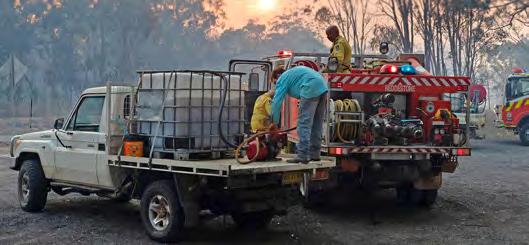
2 BUSH FIRE bulletin | INCIDENTS

When you have fast-running grass fires that you can’t keep up with, the situation is incredibly dangerous.
Angus McDowall, RFS Operational Officer
Northern Tablelands District
Unfortunately, many of these fires started in difficult to access terrain and were unable to be contained by aircraft.
Over the next few days, crews continued to work tirelessly under hot and windy extreme fire danger conditions. Firefighters from both states joined forces to manage the large number of fires across a significantly large area of operations with limited resources.
Prolific growth of longer grass had changed the dynamics of the fires compared with the 2019/20 Black Summer blazes. Grass fires were moving much faster than previously expected, quickly cutting off roads and threatening properties.
“When you have fast-running grass fires that you can’t keep up with, the situation is incredibly dangerous,” said Angus McDowall, RFS Operational Officer at the Northern Tablelands District.
DATES OF FIRE ACTIVITY
The Section 44 lasted thirty-five days from the start of the Wallangra Rd fire within the Inverell LGA on 11 October, until the revocation on 15 November.
TOTAL HECTARES BURNT
Note: These statistics are for the major fires for the entire Section 44 declaration. There were several other smaller fires lit by lightning on the afternoon on the 26 October that were able to be extinguished, so the final figure for total area burnt is slightly larger.
NAME LGA SIZE (HA) Ogilvie Dr Tenterfield 4,632 Back Creek Tenterfield 138 Rocky River Rd Tenterfield 1,995 Bonshaw Rd Inverell 2,432 Scrub Rd Tenterfield 1,645 Benders Creek Tenterfield 7,814 Frost Rd Tenterfield 8,214 Christies Tenterfield 10,933 Magistrates Trail Tenterfield 4,385 Sawyers Creek Tenterfield 7,858 Deepwater Complex Glen Innes Severn 1,500 Bukkulla Rd Inverell 346 Wallangra Rd Inverell 4,154 TOTAL AREA BURNT 66,922
ASSESSMENT TYPE LGA TOTAL Homes: Damaged 3 Destroyed 1 Outbuilding: Damaged 31 Destroyed 18
Main photo: Courtesy of Barney Downs Brigade.
Left: Photo by Jim A Barker, @thejimclasshero
BUSH FIRE bulletin | INCIDENTS 3
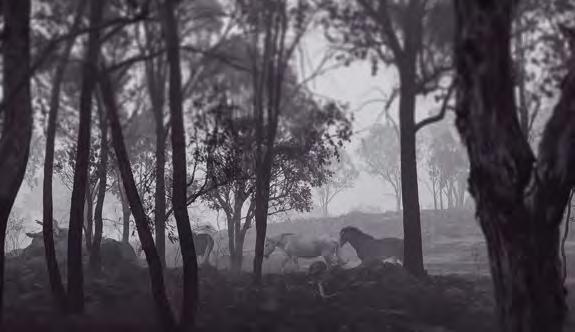
“In some areas, the grass has cured and dried off completely,” he said. “Despite rain, the cured and dead grass triggers a dangerous fuel load.”
On 31 October, hot and windy conditions continued to fan the fires in the Tenterfield and Inverell LGAs. Thirty-nine of 46 local brigades were involved, with strike teams deployed from Western Australia and South Australia, NPWS, FRNSW and Forestry Corporation, as well as five local units.
By the afternoon, there were 10 fires at Emergency Warning across the state, the highest amount
concurrently since the 2019/20 Black Summer fires. Angus said the outcome could have been far worse.
“If it wasn’t for the combined effort of farmers and their farm firefighting equipment, firefighting agencies, heavy plant and aircraft operators, emergency services and government, the outcome could have been terrible.
“It took an incredible effort to bring these fires under control and limit their impact on the community.”
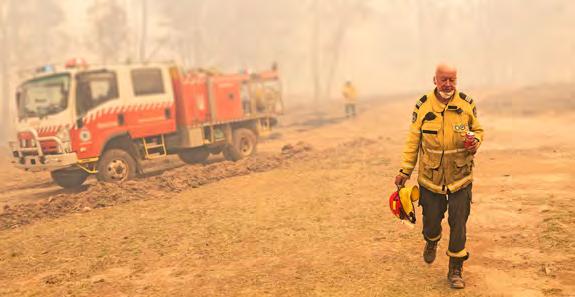
4 BUSH FIRE bulletin | INCIDENTS
Photos by Jim A Barker, @thejimclasshero

On 31 October 2023, the Christies fire crossed over the border from Wallangarra in Queensland to threaten the NSW town of Jennings. Locals were forced to take shelter at a local paddock as the fast-moving fire moved through the town. RFS Community Field Liaison Officers (CFLOs) Catherine James and Kristie Baxter were the on-ground engagement between the RFS and the community before, during and after the fire. Below, Catherine shares the timeline of their day.
1030hrs:
We arrive and drive through the townships of Wallangarra and Jennings, visiting the local fire and police stations but they are unattended. Realising no main gathering areas have been organised, we speak to the Post Office.
1100hrs:
Kristie and I commence initial door knocks on several streets in Jennings to alert them to the fire burning across the border in Queensland (thought to be in Ballandean).
We advise locals of current and planned road closures around the Tenterfield area and discuss their plans to stay and defend or leave if the fire approaches. We communicate with those at risk to be alert and aware of any changing conditions.
1200hrs:
The fire conditions across the border to the northwest escalate. I advise the Community Liaison Officer in the Incident Management Team (IMT) and send photos through Firemapper.
We receive intel from a local farmer that the fire might be much closer than previously thought (at Saxby rather than Ballandean).
We immediately report the update to the IMT.
1230hrs:
Kristie and I make our way to Saxby-Reid Rd, Wallangarra. We take further photos and provide updates to the IMT.
We speak with QLD Police to see if there is any intel on the fire and see three QLD RFS trucks making their way to the fire trail area. Conditions continue to deteriorate as the fire moves south.
1300hrs:
We make our way up to the Wallangarra cemetery, which is the township’s only high point, to get a more accurate view of the fire movement.
Once there, we speak to several locals, advising them of the escalating fire conditions, then provide intel updates to the IMT.
1415hrs:
The conditions continue to deteriorate, and we identify that there are either two fires or two fire fronts. We report estimated distance and behaviour to the IMT.
Kristie and I proceed to doorknock most northwesterly houses in Wallangarra and then revisit owners on a couple of streets in Jennings to advise of the deteriorating conditions.
BUSH FIRE bulletin | INCIDENTS 5
Above: RFS attending Jennings fires. Photo by Kristie Baxter.

There is no designated Neighbourhood Safer Places (NSPs) in either township, so we decide on a cleared area where a large sign indicates the Queensland border, if needed.
1445hrs:
Locals alert us that the fire is heading east towards the Wallangarra main township. As the fire front runs across the New England Highway, we turn cars around to prevent them entering from the south and triage those exiting from the north.
A truck with its trailer fully engulfed in flames exits the fire front and spills debris onto the road. Behind it are several cars that have been burned along one side as the fire front crossed the road and caught them in its path.
I radio the sitrep to Firecom and request an ambulance for one member of the public with severe burns.
A RFS Category 1 tanker arrives on the scene to attend to the burning truck, while we direct cars south to escape the flames.
With additional fire appliances not yet on the scene, we proceed parallel to the fire path, advising residents who aren’t prepared to defend their properties that the fire has overrun the highway to the north, so the safest option is to leave now south towards Jennings.
Kristie and I attend to an elderly gentleman with mobility issues who is in the direct path of the fire, assisting him to a neighbour’s vehicle and giving them instructions to head south. Another elderly man living in the line of the fire needs immediate assistance after realising that his car is damaged, and house is not defendable.

RFS and Queensland Fire and Emergency Service (QFES) appliances start arriving on the scene as we help the gentleman into our vehicle and get him to safety.
RFS and QFES crews commence property protection along the north end of the townships.
1525hrs:
A QLD Emergency Warning to seek shelter is issued. We instruct all people already fleeing from Wallangarra township to head to the border sign area immediately.
We set up a road point on Merinda St near the Raleigh St intersection and divert all cars trying to leave via the New England Highway to the cleared area.
1529hrs:
RFS issue an Emergency Warning via text to ‘Shelter now –it is too late to leave’.
1530 - 1730hrs:
Both townships either side of the border affected by fire are now without power. More than 150 community members leave their properties to seek shelter at the border sign, as NSW Police and RFS Group Officers arrive on scene.
Kristie and I provide ongoing intel to the IMT and the State Operations Centre.
When the immediate fire danger passes, we purchase water and snacks at a local service station for the locals seeking shelter.
6 BUSH FIRE bulletin | INCIDENTS

1730hrs:
Police permit people to return to their properties.
1800hrs:
The fire has passed down the eastern and western flanks of the townships. The New England Highway is closed in both directions as the fire crosses the road to the north and south of the townships.
1800 – 1900hrs:
The fire is downgraded from Emergency Warning to Watch and Act. We receive intel that the wind change will likely re-threaten the townships later that evening.
Kristie and I attend properties along the western edge of Wallangarra to check on residents who have returned.
We advise those living in the middle of Wallangarra and Jennings about the closure of the New England Highway in both directions and of the anticipated return of smoke and fire activity.
We discuss preparations with the locals who plan to defend (PPE, footwear, filling water buckets and watching for ember attack, etc.) and remind them of the makeshift NSP if needed.
1915hrs:
Fire activity picks up from the south. We door-knock on affected streets in Jennings. Multiple appliances begin arriving in anticipation of the fire approaching. Kristie and I assist an elderly couple who were about to go to bed and help to repack their campervan in the event of another Emergency Warning being issued.
We doorknock on several more streets to find out who is staying and defending and who is leaving to go to the border sign. We gather information including water tank capacity details and communicate to RFS crews on the scene.
2015hrs:
Kristie and I finish door knocking and attend the Wallangarra community hall, which has been opened for people to gather.
2015 – 2100hrs:
We remain with community members in the hall while awaiting intel on options for returning to Glen Innes or booking accommodation for the night in Stanthorpe.
2100hrs:
We drive south to Tenterfield and on to Glen Innes, reaching the Fire Control Centre at 2300hrs.
Thankfully, the Jennings/Wallangarra townships weren’t further threatened by this fire. We returned to visit them later in the week to provide support for a community meeting and to conduct building impact assessments.
We’re grateful that the townships had a good outcome, all things considered.
BUSH FIRE bulletin | INCIDENTS 7
Top left: Catherine, speaking to a local. Middle photo: Plains Station Road, Tabulam. Top right: The park with the border sign, that served as a makeshift NSP. Photos by Kristie Baxter.
In October 2023, 30km southwest of Grafton, a fast-moving fire burning on Glens Creek Road reached an Emergency Warning level and threatened homes to the west of Nymboida.
CLARENCE VALLEY FIRE TAKES HOLD
The Glens Creek Road fire was first detected burning in bushland north of Nymboida in the Clarence Valley at around midday on Sunday the 22 October 2023.
Superintendent Stuart Watts, District Manager of Clarence Valley, was appointed by the Commissioner as the Section 44 Incident Controller and was supported by a multi-agency Incident Management Team throughout the fire.
“By the afternoon we had issued a Watch and Act to prepare to leave for residents in the vicinity of Glens Creek Road and Frickers Road, near Nymboida,” he says.
Three hours later, Stuart watched on as the fire behaviour increased dramatically and began to develop its own weather pattern.
“It was erratic, starting spot fires ahead of the main fire front and impacting roads,” says Stuart. “It became clear that it was unsafe for residents to leave, and we issued an Emergency Warning for residents to shelter in place.”
Firefighters reported that the blaze spread quickly through areas previously burnt in the 2019/20 Black Summer fires, with more than 1,500 hectares of land burned within the first 24 hours.
The rugged, dense terrain in the area caused a rapid escalation of the fire’s level of risk.
“The fire burnt in front of itself, with the flame height reported up to almost 10 metres in some places, it was far too high for our firefighters to get in front of,” says Stuart.


8 BUSH FIRE bulletin | INCIDENTS
CLARENCE VALLEY FIRE FACTS
DATES OF FIRE ACTIVITY
22 Days
Fire began: 22 October 2023 Fire ended: 13 November 2023 (contained 7 November)

“Under these conditions, we were forced to return to property protection as suppression was no longer an option and was unsafe for crews.”
On Wednesday 25 October, the RFS had anticipated a challenging day under forecast conditions, with the fuel type, drought conditions and high winds all playing a role.
A portion of the blaze had been sitting in a bowl-like valley, which meant the fire was able to quickly race up the easternmost aspect causing a convection to form.
“The energy only had one place to go and that was up. When it did, we noticed lighting, down bursts, spotting behaviour and small fire tornados,” says Stuart.
“The conditions had developed into a pyrocumulonimbus cloud, which was a trigger to tell residents to immediately shelter.”
Over the next few days, a cool front moved in with low cloud and light rain, supressing the fire activity and allowing crews to work towards a containment strategy. By 7 November, the fire was reported as being contained and on 13 November, it was officially declared out.
Stuart praised the RFS brigades and members involved for their hard work.
“They did an extraordinary job to protect lives and property in terrible conditions. We were only able to start gaining control due to a change in weather to milder conditions in the early evening.”
AREA BURNT
12,773.58 ha
PROPERTY LOSS
Two homes and 15 sheds lost
During the clean-up, Stuart met with several property owners who were still rebuilding from the 2019/20 fires –80 homes in the area were lost to fire during that season. With the new threat of their homes again under attack, locals had provided people with accommodation, fresh bedding, clothes and toiletries, while offering support to each other.
“The area was devastated by bush fires during Black Summer and in tight knit communities such as Nymboida, locals really rally together,” said Stuart.
“It was truly humbling to hear their stories.”
 Main photo: Photo by Ivan Perkins, performing an air attack role. Above: Photo by Mark Bathgate. Below: Aerial image supplied by RFS.
Main photo: Photo by Ivan Perkins, performing an air attack role. Above: Photo by Mark Bathgate. Below: Aerial image supplied by RFS.
BUSH FIRE bulletin | INCIDENTS 9
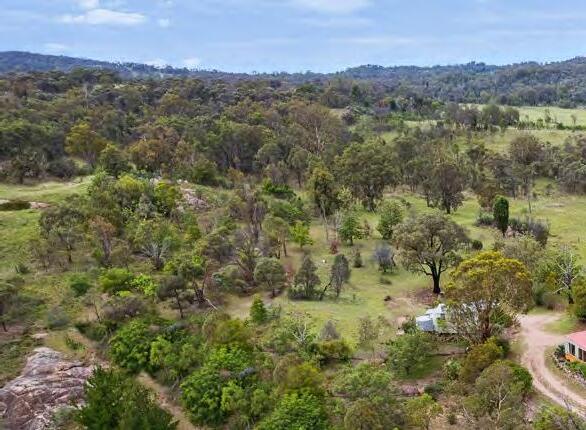
AN EXPLOSIVES FACILITY IN THE LINE OF FIRE
In October 2023, a dangerous grass fire approached an explosives storage facility in Cooks Gap, approximately 220km northwest of Sydney. The RFS and other agencies set up a 1km exclusion zone around the site and residents were immediately evacuated from the area.
At 1501hrs on 31 October, an Emergency Warning was issued when a grass fire was reported 2km south of Ulan Rd at Cooks Gap in eastern NSW.
Residents in the vicinity of Lagoon and Ulan Roads were told to leave south towards Mudgee (a further 36km away), as the fast-moving fire impinged on explosives in a nearby storage facility. As the fire spread in an easterly direction impacting on mine land, firefighters were on high alert.
The fire had already impacted the plant and burnt around the perimeter when a safety alert was sent out to all crews and supporting agencies such as Fire and Rescue NSW (FRNSW).
As the fire moved in a northeasterly direction, the Local Emergency Operations Controller, the Local Emergency Management Officer and mine management immediately set up a 1km exclusion zone.
Superintendent Troy Porter, Cudgegong District Manager, was taking measures for a potentially serious outcome.
“With extremely hot and windy conditions on the day, and dry fuel loads, we were preparing for the worst,” Troy said.
“The volatile bush and grass fire posed a very serious threat to the storage facility, which contained enormous stocks of Ammonium Nitrate, storage magazines and other explosives,” he said. “When we realised that the fire had impacted the magazines, that was the catalyst for the 1km exclusion zone.
“As the exclusion zone was set up, an urgent meeting was held with management on how we could determine if a truck containing Ammonium Nitrate had been impacted by fire in any way.
“We immediately contacted the State Air Desk (SAD) asking for the use of a FRNSW drone from Bathurst, which we decided against – as it would have taken around 2.5 hours to arrive.
10 BUSH FIRE bulletin | INCIDENTS

“Successful discussions with the mine then resulted in using one of their drones to assess the damage in the exclusion zone,” said Troy.
“At the same time more talks were undertaken with the SAD for the use of two fixed wing bombers to help control the grass fire.
“Once the drone flight was complete, the mine representatives sent through the footage, which was given to their management. After an urgent meeting, clearance to enter the plant was given to crews.
On close inspection of the site, thankfully, the fire was brought back to a Watch and Act,” said Troy.
After almost 10 days of defensive firefighting and 181 hectares burnt, crews were eventually able to moderate the fire behaviour with the assistance of heavy plant and aircraft.
On 9 November, the fire was officially declared out with no significant damage to the explosive storage facility or neighbouring properties.
Below: The Ulan Road flanked by fire, near the facility.
Photos supplied by RFS.

BUSH FIRE bulletin | INCIDENTS 11
IN FOCUS
ELECTRIC VEHICLE TRAINING AVAILABLE FOR MEMBERS
As the sales of electric vehicles continue to rise in NSW, so does the need for our members to learn new skills to cope with the challenges these vehicles pose. Electric Vehicle Incident and Emergency Response training is now available for RFS members on FUEL. The course has been developed by TAFE NSW, with assistance from Fire and Rescue NSW and the RFS, and is based on in-depth research into the characteristics, hazards and suppression options for battery fires in EVs and other applications.
The course content aligns with existing RFS operational procedures for all emergency response agencies to improve safety and confidence of first responders attending EV incidents. As new technologies appear on the market, fire services are rapidly reviewing and adapting our practices to manage emerging hazards and burning characteristics. As we learn more about them, our firefighters will be able to deal with these incidents more effectively.
All RFS members and operational staff are encouraged to complete the training, which will take approximately 2.5 hours. It can be accessed on FUEL under ‘Foundation Courses’.
For more information about EV training please contact the Operational Improvement Team at operational.improvement@rfs.nsw.gov.au.
STRUCTURAL HELMET ROLLOUT UPDATE
After an extensive evaluation program with members, the MSA Gallet F1XF has been selected as the new structural firefighting helmet and will be rolled out to all currently accredited RFS Structural Firefighters (SFF).
The new MSA Gallet structural firefighting helmets are primarily for internal structural firefighting only, and shouldn’t be worn inplace of the current general purpose helmet, the Pacfire BR9.
Due to the increased weight of the helmet it’s recommended that the general purpose helmet is used for support roles such BACO.
In consultation with Districts, individualised helmet kits will be provided to accredited Structural Firefighters and delivered to District locations across the state.
Helmet kits will include the MSA Gallet F1XF in required rank colour and size (medium or large), neck curtain, twin speaker boom mic, lighting and stickers and ranks.
To confirm your helmet size, a member of your District office will reach out to verify details. To ensure the greatest accuracy of fit, be sure to measure while wearing your flashhood.
To find out more about the MSA Gallet F1XF helmet, please view the Connect Now video by scanning the QR code at left.
Questions about the helmet may be forwarded to engineering@rfs.nsw.gov.au


12 BUSH FIRE bulletin | INFOCUS
‘NO REGISTRATION’ TRIAL FOR FARM FIRE FIGHTING VEHICLES
A trial scheme aimed at enhancing fire response capabilities in rural areas has been completed in collaboration between Transport for NSW and the RFS. The trial enabled the use of private Farm Fire Units (FFUs), also known as Farm Fire Fighting Vehicles, without registration, provided they met specific eligibility criteria.
The nominated FFUs were asked to comply with stringent guidelines, including the permanent attachment of firefighting equipment, operation within a 100km radius and the storage address to be maintained in a safe operating condition. These measures ensure that while not registered, the vehicles are adequately equipped to assist in emergency situations and contribute effectively to firefighting efforts.
The scheme was in response to the RFS recognising and valuing that in many parts of the state our RFS resources are supported using private equipment, including FFUs, to fight and contain fires. The trial was conducted to ensure more landowners can work towards protecting their own and neighbouring properties from fire.
Transport NSW will now assess the results of the trial and will be working closely with the RFS to deliver a framework to enhance response capabilities to landowners.

ACCREDITED RESILIENCE FIRST AID (RFA) TRAINING
The RFS Mental Health Services team is offering Resilience First Aid Training (RFA) for all staff and volunteer members. The course is an accredited strength-based approach to build knowledge and skills for proactive mental wellness.
Designed to help improve resilience and to proactively manage mental health and wellbeing, the training will assist those interested in improving skills to support people, family, friends, work colleagues and fellow brigade members.
A range of topics are covered, from how to proactively build mental wellness in people you care about, how to support others, impactful language, how to respond when someone is struggling and ways to connect meaningfully to support those around you.
The online course is designed to take approximately 14 hours (with a recommendation of one hour per day) and is to be completed within three months. Remember to complete all the modules marked as Resilience First Aid (RFA). The course is open until 30 June 2024.
The name you register with will be provided on your certificate of attainment and will be available as a PDF on completion. Please include your physical address for mailing of the Resilience First Aid Kit.

To access the online course please scan the QR code. BUSH FIRE bulletin | INFOCUS 13

CROPPING STATION’S YIELD UP IN SMOKE
On 27 October 2023, RFS members attended an enormous hayshed fire at Petro Station, a large-scale dryland cropping station located in the southwest of NSW, 50km northeast of Mildura.

At 2331hrs on 27 October, three RFS appliances responded to a fire at Petro Station, making their way to the remote location.
Upon arriving at the scene, firefighters quickly realised that nothing could be done to save the main shed structure due to the enormous scale of the fire.
Superintendent Stephen Walker, District Officer at the Lower Western District, described the conditions as an inferno.
“We couldn’t get anywhere near the fire, the heat coming from the shed was so intense that all we could do was try to contain the fire from a distance,” says Stephen. “The crews faced a desperate battle to try manage the blaze, which had probably been burning internally for a couple of days to the structure of origin.
“Our main concern was a large tank close to the shed that contained diesel fuel. There was a real risk it could explode, causing a very serious incident.”
Crews were tasked with asset protection of the tank and other neighbouring structures. Meanwhile, Petro Station’s
staff were able to utilise farm equipment in the battle to save other outbuildings.
Due to the large quantity of hay ignited, the fire continued to burn for three hours into the night. Unfortunately, the shed and thousands of dollars’ worth of hay were destroyed. Crews departed at 0230hrs and the fire was contained and secured to a single structure.
WHAT CAUSES HAY SHED FIRES?
There are generally two main causes of hay shed fires. Occasionally, in hot weather, dry hay may be set alight by sparks from different sources such as machinery and exhausts. Hay is also very vulnerable to bush or grass fires unless care is taken to prepare a firebreak before hot weather.
However, most hay fires are caused by spontaneous combustion, which happens when moist hay naturally generates enough heat to burn. If enough air is present, the moist hay can get hot enough to ignite with fire then spread through the stack or shed.
14 BUSH FIRE bulletin | INCIDENTS

WHAT CAN BE DONE TO MITIGATE THE RISK?
Farmers sometimes move their hay bales inside before they are fully dried out due to the risk of loss from rain and moisture if left outside.
Unfortunately, stacking wet hay poses a significant risk of catching fire. Hay bales should sit outside to dry for a few days before moving into storage.
Risk of heating is also affected by bale size, density and how hay is stored. Storing lesser volumes of smaller bales, which have a relatively large surface area, allows the heat to dissipate.
Look for signs of heating and monitor temperature if the hay moisture level is known to be high due to rain or heavy dew after baling.
Bale temperature can be tested using metal rods. Signs of possible heating include steam or condensation under the roof or a caramel or burnt tobacco smell.
Once smoke is visible, this indicates the problem is serious. Heating may be noticed within days of baling wet hay but can occur for up to 10 weeks after baling.
Reference: RFS and Department of Primary Industries
PETRO STATION
Petro Station is a large agricultural cropping station, set on more than 26,000 hectares of land and located approximately 50km from Mildura and the Victorian border.

BUSH FIRE bulletin | INCIDENTS 15
Main photo: Supplied by RFS. Below: Photo courtesy Petro Station.

WORLD CLASS AVIATION CENTRE OF EXCELLENCE FOR THE RFS
All communities across NSW are set to benefit from an enhanced emergency response facility, as the RFS officially opens the new Aviation Centre of Excellence.
On 11 December 2023, Minister for Emergency Services Jihad Dib opened a new $8 million state-of-the-art Aviation Centre of Excellence in Dubbo. The facility is the first of its kind in Australia and will be a base for specialist aerial firefighting personnel to train and prepare for responding to emergencies.
Located next to the RFS State Training Academy near Dubbo Regional Airport, the Aviation Centre is now home to four aerial training simulators for personnel to hone their skills in helicopters, fixed-wing aircraft and winching in a controlled environment. The latest technology will recreate realistic scenarios faced in recent fires to help aircrews respond across a variety of aircraft.
Minister Dib spoke about the Government’s commitment to supporting the RFS. “Emergency Services require the tools and resources to protect our communities from the everpresent threat of bush and grass fires,” said Minister Dib.
“Around the world, aviation resources are playing an increasingly important role in firefighting efforts and new technologies are helping improve the way we target fires, so upskilling in this area is essential.”
The RFS provides training for more than 140 personnel to support aviation operations in a variety of roles including Air Attack Supervisors, Air Observers, Air Base Managers, Air Base Operators, Aircraft Officers and Air Operations Managers.
Most personnel who perform these roles are RFS volunteer members across the state who receive specialised training.
Housing two dedicated training spaces and 27 accommodation rooms, the new centre will be available for use by RFS personnel as well as those from partner agencies.
16 BUSH FIRE bulletin | RESEARCH AND TECHNOLOGY


The four aviation simulators are in addition to four winch simulators operated at RFS locations in Mogo, Armidale, Lithgow and Glendenning.
RFS Commissioner Rob Rogers stressed the importance of having a purpose-built training centre.
“This is a game-changer for our personnel, providing an invaluable platform for refining skills critical to aerial firefighting, contributing to the overall readiness of the Service,” he said.
“The aviation simulators at the Centre provide the RFS with the ability to safely train and develop skills that may be too unsafe to test in a real-world bush fire environment.
“These programs expand the experience and skills of our highly trained personnel and further increases the protection of residents across the state.”

AVIATION TRAINING SYSTEMS
The RFS aviation training system has been developed and designed to simulate Air Attack Supervisor and Air Observer roles, with the ability to incrementally increase training intensity.
Virtual reality headsets are used to simulate all types of weather and fire conditions, and enable the personnel to look in, around and out of a visual representation of a full aircraft.
The helmet-mounted devices simulate air traffic management and enable the instructor to alter scenarios to create new and exciting challenges.
The Aviation and Operational Capability teams will continue to assess how best to integrate the simulator as part of our broader aviation training program.
BUSH FIRE bulletin | RESEARCH AND TECHNOLOGY 17
Main photo: Exterior of the new RFS Aviation Centre of Excellence in Dubbo, NSW Below left and right: Simulators used in aviation training.
PROLIFIC VEGETATION GROWTH FUELS NEW FIRES

Since the Black Summer fires of 2019/20, areas that were burnt have seen thick vegetation return in the form of ferns, grasses and shrubs. This abundant regrowth has led to a temporary change in the behaviour of fires this season.
Normally, an area of recently burnt forest will prevent or slow the spread of fire through that area for some time. However, in the 2023/24 season, several fires spread rapidly through areas burnt during Black Summer. This increase in fire activity has been due to several factors:
1. Above average rainfall in the years after Black Summer has led to widespread growth in vegetation such as ferns and grasses near the surface, as well as elevated fuels such as shrubs.
2. Dry and warmer than average conditions have dried the vegetation out and made it highly susceptible to burn.
3. Under dry and windy conditions, fires are spreading rapidly with tall flame heights.

While the near surface fuels (grasses and ferns) and elevated fuels (shrubs) have regrown and are abundant, surface fuels (leaf litter and bark) produced by canopy tree species are still recovering slowly. Under elevated fire danger conditions fires can spread quickly, moving through previously burnt areas and behaving more like heath or shrubland fires than forest fires.
It is important firefighters and Incident Management Personnel (IMP) are aware these areas previously burnt cannot be relied on to halt, slow or moderate the spread of fire, especially during dry and windy conditions.
2023/24 EXAMPLES OF ELEVATED FIRE ACTIVITY
Coolagolite Road fire (Bega Valley)
Fire spread rapidly through areas burnt by the Badja Forest Rd, Countegany fire in 2019/20. Approximately 7,300ha burnt and two houses lost.
Willi Willi Road fire (Kempsey)
Fire spread rapidly through areas burnt by the Carrai East fire in 2019. Approximately 29,000ha burnt and several houses lost.
Scrub Road fire (Tenterfield)
Fire spread rapidly through areas burnt by the Mount McKenzie Rd fire in 2019. Approximately 1,650ha burnt.
Glens Creek Rd fire (Nymboida)
Fire spread through areas burnt by the Liberation Trail fire in 2019. Approximately 12,770ha burnt and two houses lost.
18 BUSH FIRE bulletin | RESEARCH AND TECHNOLOGY

In contrast, a lack of surface fuels under milder conditions may cause a fire to struggle, which leads to poor results during backburning and prescribed burning.
Without stronger winds or good continuity in the surface fuels, fire will not spread (or move between areas of fuel).
Finally, IMP and firefighters should stay alert and take into account areas burnt in 2019/20 may not slow or stop a fire. Under elevated fire weather such as dry and windy conditions, they are still a risk.
CSIRO’S 10% RULE OF THUMB
A useful tool for predicting when a fire may spread quickly through forest, including those areas burnt during Black Summer, is CSIRO’s 10% Rule of Thumb.
The rule of thumb states that when wind is more than 30km/h and forest fuels are very dry (fuel moisture less than or equal to 7.5%), a fire will travel at approximately 10% of the average wind speed.
For example, this means if the wind speed is 40km/h (and fuels are very dry) the fire will travel at around 4km/h.
 Main image: Toorooka, NSW, burnt during recent fires.
Bottom left: RFS firefighters at Hat Head, NSW. Photos by Amanda Williams. Below: Willi Willi fire, 2023. Photo supplied by RFS.
Main image: Toorooka, NSW, burnt during recent fires.
Bottom left: RFS firefighters at Hat Head, NSW. Photos by Amanda Williams. Below: Willi Willi fire, 2023. Photo supplied by RFS.
BUSH FIRE bulletin | RESEARCH AND TECHNOLOGY 19
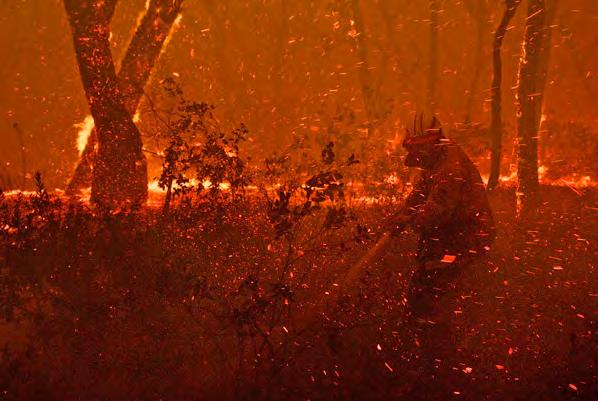
2013 BLUE MOUNTAINS BUSH FIRES
During a hot and dry couple of days in October 2013, wind gusts of up to 100km per hour turned three fires in the Blue Mountains into infernos that spread through several townships and destroyed hundreds of homes.
STATE MINE FIRE
Location: Marangaroo, Wednesday 16 October 2013
Area burnt: 54,862ha.
Duration: 34 days
Cause: Ignited by an explosives exercise at Marangaroo Army Base, which was being used for demolition training
Losses: Five homes destroyed and one damaged.
At 1200hrs on Wednesday 16 October 2013, a fire started at the State Mine Gully Army Base at Marangaroo, 5km north of Lithgow. Firefighters were unable to attack the fire at the base because of possible unexploded ordinance, and aircraft were unable to assist due to a no-fly zone.
As the fire spread, it made its way into rugged, largely inaccessible country with heavy fuel loads. Although ground crews worked tirelessly, aircraft were still unable to access from above due to smoke drift.
With high temperatures and strong winds forecast for the following day, community meetings were held in Clarence. Locals were advised that if they were not prepared to defend their property, they should leave as soon as possible.
Preparations were put in place. The Zig Zag Public School was closed for the day, and several local roads, including the Bells Line of Road, were closed.
Propelled by winds gusting up to 95km/h, the fire threatened properties around Lithgow and Clarence. Several hundred homes and the water supply were saved by firefighters as the front impacted the towns.
A number of Emergency Warnings were issued, however despite the efforts from firefighters many trains from the historic Zig Zag Railway were destroyed.
20 BUSH FIRE bulletin | FEATURES
10 YEARS ON

Crews responded to multiple calls for assistance as further Emergency Warnings were issued for the townships of Mount Wilson and Mount Irvine, which were in the direct path of the fire.
At this point, more than 12,000 hectares of bushland had been burnt. The fire had travelled more than 30km in 24 hours.
Overnight the fire threatened homes in Mount Wilson, destroying two. Crews continued to work hard late into the night, when easing conditions allowed the fire to be downgraded.
A major backburn was undertaken from Bell to Mount Wilson Road to prevent the fire spotting into the Grose Valley and spreading towards the lower Blue Mountains.
Throughout the following days, community briefings were held at local shopping centres. Strong and gusty southwesterly winds intensified, leading to an Emergency Warning being issued for the area west of Bilpin.
Residents in Mount Irvine were told to shelter in place as fire was in close proximity to roads leading away from the area. The fire had crossed the Bells Line of Road into unburnt bushland west of Bilpin.
Further Emergency Warnings were issued in Hartley Vale and near Lawson’s Long Alley. Crews door-knocked residents in Yarramundi, Bilpin, the Grose Valley and Bowen Mountain to inform them of community meetings. Firefighters continued backburning and suppression operations for a further 25 days.
After sustained rainfall which lasted several days, the State Mine fire was officially declared out on 19 November 2013.
LINKSVIEW ROAD FIRE
Location: Springwood, Thursday 17 October 2013 Area burnt: 3,631ha.
Duration: 28 days
Cause: A tree falling on powerlines
Losses: 195 homes destroyed and 145 buildings damaged
At 1330hrs on Thursday 17 October 2013, a resident of Linksview Road Springwood heard a loud sound and saw a tree had fallen onto overhead powerlines.
Emergency personnel arrived quickly but were helpless in the face of the flames. By 1500hrs, the temperature had reached 30ºC and the fire had spread rapidly southeast through bushland and crossed Hawkesbury Road.
Main image: A RFS Wallerawang 7A crew member comes under ember attack while trying to save a home near Dargan on the Bells Line of Road, 17 October 2013. Photo by Wolter Peeters / The Sydney Morning Herald.
BUSH FIRE bulletin | FEATURES 21
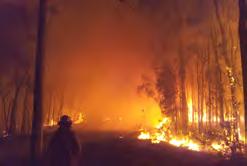
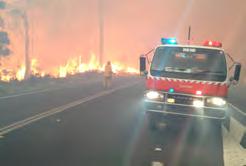
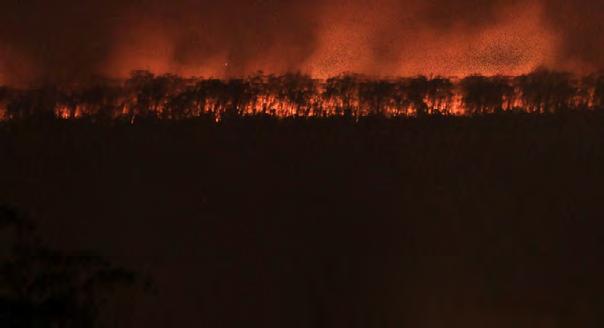
As the fire occurred in the middle of the day on a weekday, hundreds of students were trapped in schools as the fires swept east from Springwood to Winmalee. The Principal of Winmalee Primary School, who was unaware that his own home was on fire and was subsequently destroyed, walked 500 of his students to safety.
Springwood Hospital was evacuated, as were a number of nursing homes. The fire behaviour was extremely intense and soon became uncontrollable. Fire response was restricted to defence of immediate threats to life and property. Fire-bombing helicopters were unable to be deployed for much of the afternoon due to high winds.
The inferno ripped through the Springwood, Winmalee, Yellow Rock, Mount Riverview, Emu Heights and Castlereagh areas. Hundreds of locals gathered at evacuation centres at Bilpin Community Hall, Blackheath Community Centre and Springwood Sports Club.

The community was left devastated, as several hundred property losses and damages occurred in the first few days. Over the next week, crews worked on backburning north of Springwood. Several Watch and Act alerts were upgraded to Emergency Warnings because of ember attacks. Further community meetings were held in Warrimoo and Blaxland. Wind direction remained dangerously erratic causing high fire activity, as the firefighters worked hard to keep it under control. Small spot fires continued to break out until crews finally gained the upper hand.
After almost two weeks, ground and aerial patrols started mopping up along the edges to ensure threats were eliminated. Containment lines were held and crews continued blacking out. Wednesday 13 November 2013, the devestating Linksview Road fire, which had destroyed 195 homes, was finally declared out.
MOUNT YORK FIRE
Location: Mount Victoria, Thursday 17 October 2013
Area burnt: 9,383ha.
Duration: 21 days
Cause: Ignited by the effects of arcing of electrical conductors after the impact of a tree
Losses: 10 homes
At 1225hrs on 17 October 2013, a small fire on the side of the road fanned by wind gusts of up to 100km/h took hold within minutes. Aircraft and ground crews were quickly dispatched to Mount Victoria, promptly containing the blaze. An hour later, however, the fire broke containment lines. Many residents attempted to leave the area but were advised it was too late. They were informed to return to their homes immediately and seek shelter.
22 BUSH FIRE bulletin | FEATURES
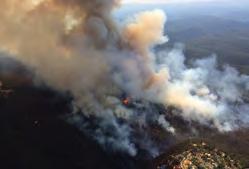
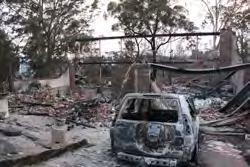

Despite the rapid response from crews, the blaze quickly spread, resulting in the loss of 10 homes and a number of sheds, garages and cars.
Due to extreme weather conditions, a number of communities were on high alert with concerns the fire may impact the Great Western Highway and rail corridor. Resources were committed to try to contain the breakout. Community meetings were organised in Medlow Bath and Blackheath, attracting more than 2,700 attendees.
Then RFS Commissioner Shane Fitzsimmons called an emergency meeting of the Incident Controllers to discuss the current situation, and it was determined that an overarching IMT would be established to coordinate resources and response for all fires.
Following discussions, a high-risk strategy known as ‘The Plug’ was outlined and became central to the fight to protect the Blue Mountains.
Involving backburning off a steep and difficult section of bushland, the strategy was high-risk as the terrain was inaccessible to firefighters. The 5km containment line was to be constructed by hand by specialised Remote Area Firefighting Teams (RAFT) in a narrow ravine at the gateway to the Grose Valley.
The strategy had been tried a number of times before and failed, due to the potential for a fire with a perimeter of more than 150km to break containment lines. RAFT were deployed and started the trek through many kilometres of rugged bushland.
Schools closed and residents in the wake of the fires were asked to leave the Blue Mountains due to extreme weather forecasts. A community meeting in Katoomba was attended by more than 2,500 people as control lines along the Bells Line of Road were breached.
Three Strike Teams were immediately diverted to protect the villages of Mount Wilson and Mount Irvine.
The wind eased and alert levels were lowered to Watch and Act, ‘The Plug’ control line in the Grose Valley was held. Over the coming days, firefighters continued mopping up despite a number of flare-ups.
The fire was finally declared out on 7 November 2013. The Section 44 fire destroyed vast swaths of bushland and 10 homes, with all losses occurring on the first afternoon of the blaze.
THE BLUE MOUNTAINS
The Blue Mountains is a unique world heritage area of approximately 143,000 hectares. Almost all of the land within that district is classified as bush fire prone land.
The 2013 fires are described as the worst natural disaster in Blue Mountains history. The cost of damage was estimated to exceed $200million.
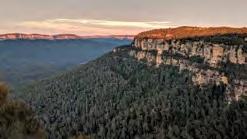
BUSH FIRE bulletin | FEATURES 23
Inset left: Bilpin 2013. Photo by Matt Hunter. Inset middle left: State Mine Fire, Barrangaroo. Photo by Ben Shepherd. Inset middle right: Aerial image of fire. Inset right: Winmalee 2013. Photo by Ben Shepherd. Top background photo by Nick McKinlay.

FOR COUNTRY
CULTURAL BURNING A MILLENNIA-OLD APPROACH TO CARING
Cultural burning is a fire practice used by Aboriginal and Torres Strait Islander people for ceremonial purposes, and to improve the health of Country and its inhabitants. This ancient type of burning has been used for more than 60,000 years to manage land, plants and animals.
Although cultural burning has not been widespread for many generations, an increased awareness of its holistic approach has highlighted the important role it can play in sustaining some native species and habitats to create healthy Country, healthy communities and also mitigate the effect of extreme bush fires.
Looking to the future, recent studies have demonstrated that Indigenous land management practices, such as cultural burning, have had positive outcomes on biodiversity through regenerating the landscape.
HOW DOES CULTURAL BURNING DIFFER FROM HAZARD REDUCTION?
Similar to cultural burning, hazard reduction burning is the process of planning and applying fire to a predetermined area, under specific environmental conditions to achieve a desired outcome – usually the mitigation of the presence or severity of bush fires.
While there are crossovers between the two practices, Indigenous burning has a cultural outcome, purpose or significance. Cultural burns can be held to strengthen connection to land, care for Country and fulfill obligations to treat the land by traditional owners.
The intent of the cultural burn is normally established –there may be a spiritual connection to the area, or the landscape may be lacking in terms of species diversity.
Depending on Country, a ceremony may be performed prior and guided by a First Nations Cultural Fire Practitioner. Cultural burning normally uses spot ignition, which results in fire that is lower in intensity and easier to control. Maintaining the canopy of the trees helps to provide shade and shelter for animals and propagates seeds for future generations.
The approach takes many factors into consideration, including the natural behaviour of animals and birds who assist by turning over and reducing the leaf litter.
COOL BURNING AND ITS BENEFITS TO THE ENVIRONMENT
Cooler burns are considered healthier for the landscape, particularly undertaken in cycles and using mosaic patterns that have a less intense and detrimental impact on the environment. One of the keys to cultural burning is understanding the vegetation indicators and the landscape’s readiness for fire to be introduced.
CULTURAL BURNING WORKSHOP
A two-day cultural burn workshop was held in August 2023 on Ngiyampaa Country in Rick Farley Reserve, near Pooncarie in southwest NSW.
The workshop was led by First Nations Cultural Burn Practitioner, Geoff Simpson, and attended by RFS Directors, Area Commanders and Area Operations staff.
24 BUSH FIRE bulletin | FEATURES

The team camped on-site, listening and learning about a range of topics.
While undertaking site observations of the ancient landscape adjacent to Lake Mungo, the team shared knowledge around caring for Country and learned the difference between a healthy and sick landscape.
Cultural burns take place at night on Rick Farley Reserve and between the months of June to August, in line with the nesting habits of the Ngiyampaa’s totem, the malleefowl.
Geoff spoke about the relevance of Indigenous burning.
“It’s vital to encourage good biodiversity through good fire, setting cultural intent,” he said.
“By considering how to approach wide-scale burning and obligation to Country, we understand the importance of relationships between each other and the land.”
Prior to undertaking the burn, Geoff held a ceremony gathered around an image of the malleefowl totem made of red sand and ochre.
CULTURAL BURNING GUIDE
The RFS is currently developing a Cultural Burning Guide to assist districts and brigades with the integration of cultural burning as a component of fire management.
Chief Superintendent Kelwyn White, Area Commander South Western, is leading this initiative. If you would like to contribute, get in touch with Kelwyn at the South Western Area office.
“The low intensity burning combined with the glow of the red sand mallee Country at night was captivating,” he said. The next morning, the group returned to the burn site for a walkthrough with tree canopies fully intact. It was a great experience with a lot of learning and listening by the group on the importance of cultural burning for healthy Country.
WHAT ARE MALLEEFOWL?
The malleefowl has more than 15 Indigenous names, highlighting its importance for Aboriginal people across Australia. These birds are stocky medium-sized ground-dwellers with large feet. Starting each year in June to August, they build enormous mounds as nests that can take almost a whole year to complete.
The malleefowl is an endangered species, whose habitat is slowly disappearing due to agriculture, mining, roads and bush fire.
 Main image: Photo by Melissa Hams, c/o NSW DPE. Above: A ceremony centered around an image of the malleefowl totem. Photo by Danny Busch. Below: A malleefowl. Photo by Melissa Hams, c/o NSW DPE..
Main image: Photo by Melissa Hams, c/o NSW DPE. Above: A ceremony centered around an image of the malleefowl totem. Photo by Danny Busch. Below: A malleefowl. Photo by Melissa Hams, c/o NSW DPE..
BUSH FIRE bulletin | FEATURES 25
MOBILE DATA TERMINALS
Status panel
The status panel displays the current status of the appliance and provides the ability to select a new status.
Status codes
All appliances assigned to the incident and their status colour code are shown on the Resource panel.
Alerted
Responding
Proceeding
On Scene
Emergency
Not available
At Station
Available

Duress
The Emergency button is used to indicate that an appliance is in duress. When an appliance is in duress, the status code EMR will be displayed and a solid red border around the MDT will be shown.
Need help with the MDT?
Try these options:
Log into Fuel and search for ‘MDT’
Start a discussion at Brigade training
Use the training environment to build your skills and confidence
For more information please scan the QR code or go to https://one.rfs. nsw.gov.au/our-organisation/priorityprojects/mobile-data-terminals for more information.
QUICK REFERENCE GUIDE

MDT rollout for 2024
The project currently has two districts live (Far South Coast and Central Coast) with a third undertaking installations now (Cudgegong). Lake George commenced installations at the start of February 2024, with a further five districts in various stages of the planning/preparation phase.
The RFS plans to roll out MDTs to 12 districts in the first half of 2024.
AFR Menu
Adashi First Response (AFR) - Incident Response Software functionality can be accessed using the buttons on the AFR menu bar located at the bottom of all AFR screens.
This bar contains three rows of buttons that can be accessed using the MENU UP and MENU DOWN buttons.
MENU UP button
MENU DOWN button
The AFR menu displays notifications as a yellow number against the specific AFR button.
When the menu row that the notification relates to is not visible, the MENU UP or MENU DOWN button displays a yellow outline to alert users, as illustrated.
Offline
When offline, it is not possible to change the status via the MDT and the radio should be used.
A solid yellow border and the message ‘Server Disconnected’ is the offline indicator.

THE FIGHT TO SAVE THE BEE: AN UPDATE ON THE SPREAD OF THE VARROA MITE
WRITTEN BY ELLIE MCNAMARA, PUBLIC INFORMATION MANAGER NSW VARROA RESPONSE.
In June 2022, a European honeybee parasite called Varroa mite was detected in NSW. A few short weeks later, hundreds of RFS volunteers and staff from across NSW were assisting the NSW Department of Primary Industries (DPI) in the response to protect our bees and their associated industries from the pest.
After discovering the Varroa mite in Newcastle in 2022, RFS members joined the fight against the incursion, under the guidance of the NSW DPI and beekeepers. Approximately 800 members stepped up to fill roles in Incident Management Teams and field operations, from Orange in the Central Tablelands to the Lower Hunter, as well as assisting in Griffith.
Unfortunately, since the mite was first detected, the situation has evolved from an eradication response to
accepting that it is here to stay and now assisting the beekeeping industries manage the mite’s presence.
The National Management Group, which is made up of all states and territories, the Commonwealth Government and 16 industry partners, has now decided that eradication is no longer technically feasible.
NSW will transition from having eradication (red), surveillance (purple) and general emergency (blue) zones, to either a suppression or management zone.
28 BUSH FIRE bulletin | FEATURES

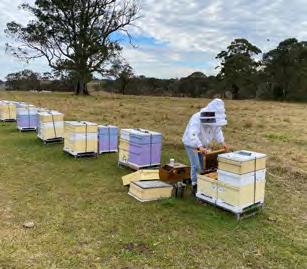

The DPI value the sacrifice of every beekeeper and thank everyone for their cooperation during the Varroa mite response and this evolving situation.
Those who have sacrificed their bees for this response should know that their help has not be in vain, and demonstrates the industry’s commitment to being part of the solution.
The aim of the transition to management program is to increase resilience and capacity to manage Varroa mite within the Australian honeybee industry, thereby minimising the ongoing impacts of Varroa mite naturalisation on the bee industry and pollinationreliant industries.
This will occur through slowing the spread, building industry resilience, providing management options and supporting pollination security.
To learn more scan the QR code or visit https://www.dpi.nsw.gov.au/emergencies/ biosecurity/current-situation/varroa-miteemergency-response
The management zones will be in the former eradication zones in the Kempsey, Hunter and Central Coast regions, and the rest of the state will be a suppression zone.
Beekeepers will be required to complete hive testing and record results every 16 weeks, with some new conditions in place to safely move beekeeping equipment around the state.
Although the mite has spread and eradication is no longer a feasible option, the DPI would like to acknowledge the support of the RFS.
Without a quick and decisive response, the mite would likely be widespread across Australia and NSW.
Leigh Pilkington, Director of Emergency Management at NSW DPI, praised the RFS for its continual support since the outbreak.
“Australia was the last habited continent to be free of Varroa mite, and I’m so proud of our collective efforts, tireless response and professionalism,” he says.
“The RFS and DPI have a long history of working together in an emergency response capacity, such as during the eradication of the red imported fire ant, equine influenza, Newcastle disease, white spot disease and many others.
“With much work ahead while transitioning to management, I view the response as a success and thank you again for all the support.”
TRANSITION TO MANAGEMENT OF VARROA MITE
BUSH FIRE bulletin | FEATURES 29
Top and above: RFS members checking for Varroa Mite. Photos courtesy NSW DPI. Main and top right: Stock photos by xiSerge from Pixabay.
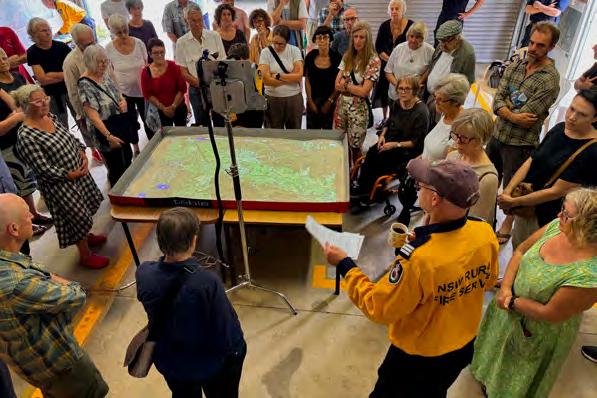
MID NORTH COAST BRIGADE HOSTS SOLD OUT EVENTS
North Bellingen Brigade members and their local community recently came together to discuss bush fire planning in a series of successful events held on the Mid North Coast of NSW.
Captain Kev Doye has always believed in the value of engaging with his local community about preparing for fire and the impacts to the natural environment.
Living on the Mid North Coast around the beautiful Bellingen area for more than 20 years, Kev is passionate about protecting his township, but has found it hard to engage the community.
“We were running some bush fire information events but finding it hard to deeply engage with members of the community,” says Kev.
“We can see less fires than other regions, however there is a history of significant blazes moving through our valleys. This can be a dangerous combination as it means we have significant fuels available to burn alongside a community that can be less bush fire-savvy.”
The Bellingen business owner and father of four was one of many volunteer firefighters called to help efforts to contain a major blaze burning at nearby Dorrigo in 2019/20 that devastated the landscape.
“After living through the recent fires and realising the importance of public engagement, we jumped at the opportunity to collaborate with Bellingen Shire Council
and the Mid North Coast Joint Organisation (MNCJO) to provide some incentives to attract the local community to our events,” he says.
The MNCJO provided a ‘Simtable’, which is a sophisticated digital sand table that displays high quality models of natural hazards such as bush fires and floods. Council also provided free emergency radios for each household that attended.
“Offering a good spread of food at each event, we went from ‘hard-to-engage’ to a series of ‘sell out’ free bush fire education nights,” says Kev.
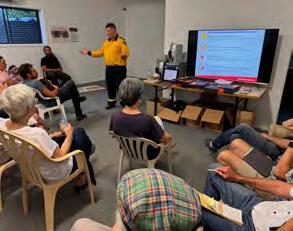 Top left: Members of the public attend the Bellingen Brigade engagement. Top and bottom right: Captain Kev Doye operating the Simtable. Bottom left: Senior Deputy Captain Simon Borgert following up with detailed bush fire planning in the training room.
Photos courtesy of North Bellingen Brigade.
Top left: Members of the public attend the Bellingen Brigade engagement. Top and bottom right: Captain Kev Doye operating the Simtable. Bottom left: Senior Deputy Captain Simon Borgert following up with detailed bush fire planning in the training room.
Photos courtesy of North Bellingen Brigade.
30 BUSH FIRE bulletin | GENERAL NEWS

“At the last in the series of workshops, we limited the numbers to 80 local families. Once again it was ‘sold out’, which was a great result.
“Attendees had the opportunity to see the Simtable in action, and have an in-depth discussion about fire planning, before sharing food and going home with a radio.”
“With a mental health support worker also in attendance, the community felt supported and able to process sometimes triggering information in a safe environment.”
SIMTABLE FOR COMMUNITY EMPOWERMENT PROJECT
The Simtable was purchased by the Mid North Coast Joint Organisation (MNCJO) with grant funds from the NSW Government’s Bushfire Community Recovery and Resilience Fund (BCRRF).
It was purchased for use by the Local Government Areas that were disaster declared in the 2019-20 Black Summer bush fires.
The project aims to improve the capacity of communities across the Mid North Coast to plan and respond to disasters, particularly vulnerable populations.
To find out more information and how you can get involved please go to the MNCJO website at www.mncjo.nsw.gov.au.
WHAT ARE ‘SIMTABLES’?
The technology uses a projector to overlay hazard projections over local mapping and terrain in 3D. The system models fire behaviour based on geophysical and meteorological conditions to demonstrate how fire might move through the landscape, and what impact it may have on the built environment.
It provides local communities with a highly realistic demonstration of how their properties and communities may be affected.
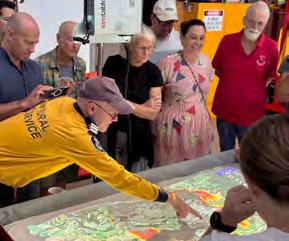
BUSH FIRE bulletin | GENERAL NEWS 31

NEW MEMBERS LEAD THE WAY
WRITTEN BY PAUL CUNNINGHAM, SENIOR ADVISOR, PROGRAM DEVELOPMENT
The Young Member Leadership College was developed for young RFS members to strengthen their current and future leadership capability.
On the 10-13 August 2023, and 4-7 April 2024, a combined 55 RFS members from across NSW aged between 18 and 30 attended the Young Member Leadership College at the Australian Institute of Police Management in Manly.
This foundational leadership program was designed in consultation with the RFS State Young Members Group and in alignment with the RFS strategic direction to strengthen leadership capability at all levels.
These programs focused on ensuring critical leadership skills are embedded at an early stage in young members. Key points discussed were how to grow into future leadership roles both within and outside of the RFS, in conjunction with their chosen careers.
Young members participated in collaborative learning activities to put their newly acquired knowledge into practice by problem solving and brainstorming together.
From the outset, both groups both showed a real passion and were highly engaged. Topics early in the program focused on ‘leading self’ in areas such as growth mindset, self-awareness, wellbeing and self-reflection.
The second half of the program had more of a focus on ‘leading others’ with topics such as courageous conversations, coaching, influencing and career planning.
All these topics formed part of final team group presentations, which were exceptionally well delivered by the participants and reinforced their learnings throughout.
Senior RFS staff members attended both programs to speak about their leadership experiences and included Commissioner Rob Rogers, Deputy Commissioner Kyle Stewart, Deputy Commissioner Peter McKechnie and A/Director State Operations Kelly Quandt.
Other evening sessions included ‘fireside chats’ delivered by the RFSA and other senior RFS staff members and
32 BUSH FIRE bulletin | GENERAL NEWS

volunteers, and a presentation on generational leadership and how it applied to the participants.
The feedback from both programs was outstanding, with the facilitators saying it was some of the most positive they had received in their years of training.
The participants were highly enthusiastic and grateful for the opportunity to attend.
The members formed a close bond during their time together, and this has continued with the group being in regular contact since.
Due to its success, the RFS will be running more Young Member Leadership College programs in the future.
For more information please contact Paul Cunningham, Senior Advisor, Program Development on 02 8741 5161 or youthparticipation@rfs.nsw.gov.au.
Top: Opening night of the inaugural College, August 2023, with 24 young members from across NSW following the opening address by Commissioner Rob Rogers. Below: Members from the recent April College enjoying a break L-R Elliot Simpson (Green Point Brigade, Mid Coast) Mitchell Tkalec (Narrabri Brigade, Namoi Gwydir) Taylor Mureau (Woombah Brigade Clarence Valley), Robbie Paull (Gulmarrad Brigade, Clarence Valley). Bottom: Ryan O’Reilly (Bemboka Brigade, Far South Coast) and Annaleise Turner (Basin View Brigade, Shoalhaven).


BUSH FIRE bulletin | GENERAL NEWS 33

THE DUKE OF EDINBURGH SUPPORTING YOUTH ENGAGEMENT
The RFS recently attended an event at NSW SES Marrickville with His Royal Highness, The Duke of Edinburgh. Four junior members from the Orchard Hills Brigade came along and met the Prince, who was in Sydney to attend a series of events with Duke of Ed participants, volunteers and community leaders.
On 23 November 2023, the Duke of Edinburgh joined the Minister for Emergency Services, Mr Jihad Dib, at the NSW SES Marrickville station. There he met with emergency responders and volunteers including Surf Lifesaving Australia, NSW Marine Rescue, St John Ambulance, NSW SES, SA SES and the RFS.
His Royal Highness Prince Edward and invited guests, including Commissioner Rob Rogers, participated in a roundtable discussion co-chaired by Mr Dib and hosted by NSW SES Commissioner Carlene York.
Current developments in achieving greater youth engagement in the various volunteer-based emergency services agencies, including the Duke of Edinburgh’s proposal to establish an Emergency Responder Corps for school school leavers, were discussed.
The main messaging of the event was around the connection of volunteering being a compulsory section of the Award and how this can help bring new young volunteers to emergency services.
Orchard Hills Brigade junior cadets Marcus Bridgman, William Watson, Emily Filewood and Wesley BertramRoels (one of our Young Volunteers of the Year), were invited to be part of the event. They discussed their experiences volunteering with the Service and participating in the Duke of Edinburgh award. Paul Bridgman, Orchard Hills Cadet Coordinator, is a RFS life member and has a focus on the youth component of the Brigade.
Community events that promote the Duke of Edinburgh Awards and the importance of Emergency Services are vital to sustaining a future generation of volunteers…
Paul Bridgman, RFS Cadet Coordinator
“Marcus, one of our cadets, got a big laugh from the Prince when discussing his participation in the Duke of Edinburgh – he’s been learning Latvian as part of the Award and the Prince wasn’t expecting that answer. The Prince said he’s travelled around the world and never heard that.
“It was a wonderful day for all involved and I am immensely proud of our Orchard Hills Brigade. We have more than 30 junior and cadet members under 18 years of age on the books,” he said.
Due to multiple reasons such as COVID-19, the impact of the 2019/20 season and living pressures, RFS volunteer numbers have decreased in some areas.
“Community events that promote the Duke of Edinburgh Awards and the importance of Emergency Services are vital to sustaining a future generation of volunteers, ensuring our communities are protected in the decades to come,” said Paul.
Main photo: The Duke of Edinburgh meeting with Orchard Hills cadets.
34 BUSH FIRE bulletin | GENERAL NEWS

RFS BENEVOLENT FUND GIVING BACK TO FIREFIGHTERS AND FAMILIES
The RFS Benevolent Fund, a charity created to provide support to RFS members and their families during challenging times, is now available to help.
Following the devastating Black Summer fires, a total of $110 million in donations was given to the RFS and the Brigades Donations Fund, with $10 million of this support channelled to establish the RFS Benevolent Fund. The Fund aims to support the families of those who lost their lives, were injured or fell ill while serving the community, and to better support our members and their families at times of hardship.
Commissioner Rob Rogers said the Service is taking vital steps to ensure that our firefighters, who risk their lives to protect others, receive the care and support they deserve.
“While the RFS already provides a range of supporting measures, the Fund will offer additional practical and compassionate support such as counselling and welfare grants to any of our members experiencing poverty, distress or other difficulties,” Rob said.
The RFS Benevolent Fund assists RFS members by: — providing direct cash payments and reimbursing beneficiaries’ expense payments — funding additional health and wellbeing services — providing interest-free loans and other support
For more information on the RFS Benevolent Fund, including details of making a donation or applying for assistance, please go to www.rfsbenevolentfund.org.au.
RETURN AND EARN
The Benevolent Fund’s first fundraising initiative raised $95,000, which will help it provide even more assistance to RFS members.
The Fund recently partnered with the NSW Government’s Return and Earn scheme, which enables people who are recycling bottles and cans to donate their returns to a charity of their choice.
Recycling through Return and Earn was a great way to give back to our fellow members. The scheme also helps the environment by reducing litter.
The Benevolent Fund was the featured charity on Return and Earn collection kiosks for the past six months, raising just over $95,000.
You can continue to donate to the Benevolent Fund using the Return and Earn app.
Look up ‘RFS Benevolent Fund’ under ‘Charities’ on the app. Press ‘Set as Payout’ to select the Fund as your active payment method.
Next time you’re at a collection kiosk, scan the app and start returning your containers.
When you’re finished, press ‘TRANSFER’ on the kiosk screen and know that 100% of your refunds will help support your fellow members.

BUSH FIRE bulletin | GENERAL NEWS 35
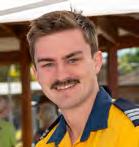
FIREFIGHTERS STEP UP TO THE CHALLENGE
RFS firefighters recently tested their stamina in two gruelling stair climbing events to raise money for cancer and mental health charities and research into Motor Neurone Disease.
FIREFIGHTER STAIR CLIMB
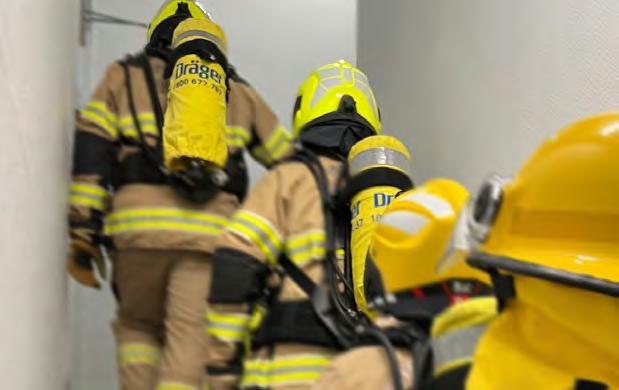
Date: 2 September 2023
Location: Melbourne
Cause: To raise money for the fight against cancer, depression and suicide
Around 600 firefighters and emergency services personnel from across Australia and the globe descended on Melbourne for the 10th annual Firefighter Stair Climb event to raise funds for several charities.
The climbers battled 28 floors at the Metropole Crown Towers in up to 25kg of turnout gear and breathing apparatus – a symbol of the burden of significant health and wellbeing issues faced by our first responders and their families daily.
The event simulates the actions of a firefighter entering a burning high-rise building, so is exclusively for firefighters in full structural firefighting clothing, some using self-contained breathing apparatus to add an extra level of difficulty to their climb.
Captain Jacob Sutherland of Woolgoolga Brigade participated in the event, representing his RFS Brigade and Fire and Rescue NSW Station 507 Woolgoolga.
“It’s hard and it’s definitely a mental and physical game, you get fatigued pretty quickly in a stair climb,” he said.
“The climb took me eight minutes to complete, with the fastest time in the opens group coming in at three minutes 42 seconds.
“It’s a rewarding experience to be able to meet emergency service personal from around Australia and the world to raise much needed awareness for cancer, depression and suicide of emergency service workers.
“I was proud to be able to represent both organisations I work for and raise much needed funds for my fellow firefighters across NSW who may be going through a hard time.”
This year, participants were encouraged to raise funds through sponsorship and creative fundraising, with proceeds going to Lifeline, Peter MacCallum Cancer Foundation and the 000 Foundation.
These charities help to improve support services, fund research, remove stigmas and raise awareness of mental health issues like depression, Post Traumatic Stress Injury and suicide.
The event raised more than $640,000. Since the inaugural stair climb in 2014, the events have raised more than $3.2 million.
A live-stream of the 2023 Melbourne Firefighter Stair Climb event is available to watch online.
For more information on how to donate or participation in 2024, please go to https://www.firefighterclimb.org.au
Main photo: Firefighters participating in the Firefighter Stair Climb in Melbourne, 2 September 2023. Inset: Captain Jacob Sutherland. Top centre: Susan Courtney of West Nowra Brigade participating in the Scenic World Stair Climb in Katoomba, 16 September 2023.
36 BUSH FIRE bulletin | GENERAL NEWS
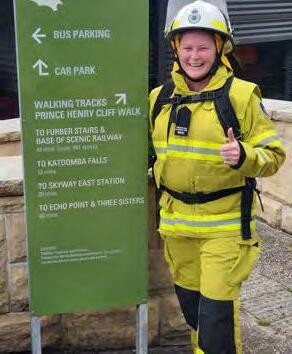
FIRIES CLIMB FOR MOTOR NEURONE DISEASE (MND)
Date: 16 September 2023
Location: Blue Mountains
Cause: To fund research into MND
The Firies Climb for MND was started in 2015 by Fire and Rescue NSW firefighter Matt Pridham after his best friend, Adam Regal, was diagnosed with MND.
After learning that there was no known treatment or cure, they became determined to join the fight to find one. Together, they pledged to raise as much money and awareness for the disease as possible.
Adam, a loving husband and father of two, lost the fight against MND in August 2018. He was diagnosed after losing his uncle and father to the same disease.
Those who suffer from MND inspire the Firies Climb, along with other people and families affected by or living with the disease. Since 2015, hundreds of firefighters have climbed the 1,504 steps of Sydney Tower Eye wearing 20kg of structural firefighting gear. During that time, more than $3 million dollars has been raised to support research into MND.
Susan Courtney has been a member of the RFS for more than 20 years and is currently with West Nowra Brigade. She first participated in Firies Climb for MND in 2016 and joined the organising committee in 2018.
“Matt Pridham aimed to raise at least $10,000 for MND research, but the first Climb with Fire and Rescue NSW firefighters raised more than $160,000,” says Susan.
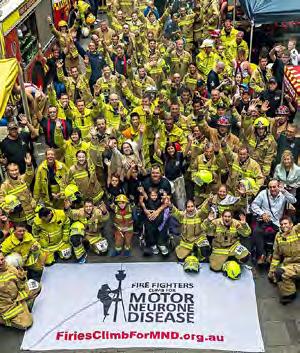
“The last Tower Climb before COVID-19 hit in 2019 included firefighters from multiple interstate and international agencies and raised just under $900,000.
“As Professor Dominic Rowe from Macquarie University says, ‘MND is not incurable, just underfunded’.”
On 16 September 2023, Firies Climb for MND hosted its most ambitious climb yet, with participants challenged to tackle the gruelling stairs at Scenic World Katoomba (a total of 951 steps down and then 951 back up) for 16 consecutive hours, starting at midnight and finishing at 4pm.
Fire and Rescue NSW firefighter Gavin Clifton started this event in 2020, this year raising more than $21,000.
For more information on how to donate or participation in 2024, please go to https://firiesclimbformnd.org.au/.
MOTOR NEURONE DISEASE (MND)
Motor Neurone Disease (MND) is a debilitating disease that results in a progressive decline in the ability to move, speak, breathe and swallow.
Unfortunately, in most cases, a person with MND will die within two to four years of diagnosis.
Who is affected?
Approximately 10% of all cases are linked to family genetics, with the remaining 90% sporadic.
Recent statistics estimate there are more than 2,000 people in Australia currently diagnosed with MND, and at least two are diagnosed with the disease every day
BUSH FIRE bulletin | GENERAL NEWS 37

SNAPSHOT OF GET READY WEEKEND 2023
Get Ready Weekend is a statewide initiative that occurs each year at the start of the Bush Fire Danger Period. Brigade events are aimed at encouraging members of the community to take actions to prepare for the coming season.
Last year, more than 590 events were held across the state in September. Following several years of wet weather, these events were an important opportunity to re-engage with the community about the returning risk of serious fires.
With multiple RFS brigades reporting record turnout, 2023’s attendance was reflective of community concerns ahead of the return to hot and dry conditions with high fuel loads.

GRW SHOWCASE AT WARRIMOO PUBLIC SCHOOL
Each year for Get Ready Weekend, children from Years K-6 at Warrimoo Public School and members of the Warrimoo Brigade come together to showcase bush fire safety and how to prepare for an emergency.
Leading up to the festival, students from Years 5-6 work on ‘Project Firestorm’, where they create displays for the community to see on the day.
 Terrey Hills
Terrey Hills
Batemans Bay 38 BUSH FIRE bulletin | EVENTS AND AWARDS
Warrimoo
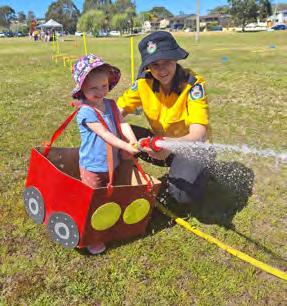
A highlight on the calendar, locals enjoy music, food and face painting while having an informal yet educational chat with Warrimoo Brigade members.
Peter Randall, Warrimoo Brigade Community Education Officer, has been involved with the collaboration since 2017.
“We start with discussions about safety around fires, to learning about household preparedness, inside and out,” says Peter.
“The program gives us a great framework to explore real life challenges and come up with responses and solutions through fun activities.”
Peter attributes the successful program to genuine community willingness to get involved and seek to understand, after the devastating fires in the area in 2013.


“Although the school has a tight safety plan in place, which the students are very involved in, the 2013 fires were a catalyst for the RFS to start conversations about mapping out a tailored program to involve the whole community,” he says.
“We’re seeking to tap into pre-existing resilience in these young people, who’ve grown up with a sense of what real bush fire risk is. I’m positive they can take their new knowledge into the future and be able to help their community if and when the time comes.”
Peter hopes the program helps to shape others elsewhere in similar communities.
“Have the conversations with different groups, find out what’s needed and what you can do as a Brigade,” he says.
 Brigade photos by RFS members on Get Ready Weekend. Warrimoo photo by Jacqueline Murphy.
Ingleside
Hazelbrook
Batemans Bay
Brigade photos by RFS members on Get Ready Weekend. Warrimoo photo by Jacqueline Murphy.
Ingleside
Hazelbrook
Batemans Bay
BUSH FIRE bulletin | EVENTS AND AWARDS 39
Alphadale
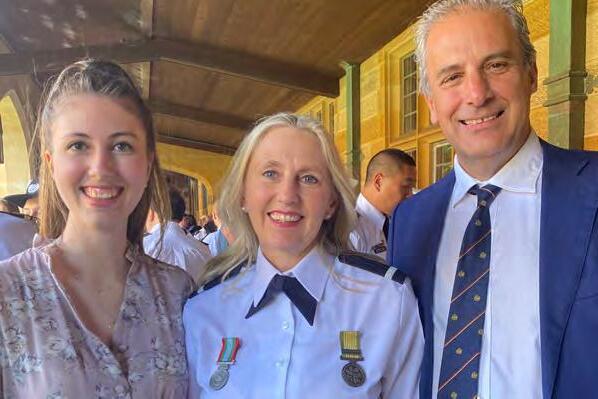
PRESTIGIOUS ST JOHN AMBULANCE AWARD FOR VALIANT RFS MEMBER
In October 2023, Deputy Captain Phillipa Drewett of Burrawang Brigade was presented with a St John NSW Ambulance Save a Life Award in recognition of her attempt to save the life of a drowned man.
On 4 March 2022, Phillipa was walking on Hyams Beach on the NSW South Coast with members of her family, when four people swimming close-by were swept out in a rip.
“The weather on the day was particularly poor, with strong winds and dangerous surf conditions,” says Phillipa.
“Luckily, a group of brave young surfers – the only other people in the water – immediately assisted the family of four and tried to pull them ashore.”
The children (aged 11 and 12) were safely dragged in but, tragically, their father suffered a heart attack while in the water and a subsequent cardiac arrest once brought to safety on the beach. Unfortunately, as his wife looked on, she too suffered a minor heart attack due to the stress.
As an active member of the RFS, Philipa called upon her first aid training and triaged the family, then calmly managed the scene and commenced CPR on the father.
“I immediately fell back upon my RFS experience,” says Phillipa. “It was my training that gave me the confidence and skills to render assistance to the family in what were extremely tragic circumstances.”
Once paramedics were on the scene, Phillipa helped to comfort the woman and her children. Tragically, their father was pronounced deceased soon after.
Phillipa’s children, who are also RFS members, were commendable in rendering assistance to the family both during and immediately following the rescue.
Dominic Teakle, CEO of St John Ambulance, praised Phillipa’s ability to think with a clear head in such a distressing environment.
“Her ability to attend to the victims with her first aid knowledge and general management of the scene, as well as offering care and emotional support during the ordeal, was outstanding,” said Dominic.
Due to delays caused by COVID-19, Philipa finally received her Save a Life Award in October 2023 for recognition of her valiant rescue attempts on the beach that day.
The prestigious award is reserved for community and emergency service members for their actions to render life-sustaining assistance to a person in need.
In late 2023, the Save a Life Award was renamed the St John Community Outstanding Clinical Care Award.
The award continues to recognise members of the community who contribute, through application of first aid skills such as resuscitation or use of a defibrillator, in emergency situations.
Photo: Deputy Captain Phillipa Drewett of Burrawang Brigade receiving her Save a Life Award, accompanied by her family.
40 BUSH FIRE bulletin | EVENTS AND AWARDS
Reflect Reconciliation Action Plan
RECONCILIATION ACTION PLAN: A STRONGER UNDERSTANDING
November 2023 – April 2025
The RFS has released its first Reconciliation Action Plan (RAP) under the Reconciliation Australia RAP framework, as the Service seeks to embed a stronger understanding of Aboriginal and Torres Strait Islander communities and cultures in fire management across NSW.
As a firefighting service working to protect the people and environment of NSW from the threat of fire and other natural disasters, our activities are closely tied to the land. By building stronger ties with communities from ancient cultures, we learn about protecting the land and recognise the benefits to be gained from the reinstatement and continuation of these practices in today’s changing environment.
Commissioner Rob Rogers said the commitment to greater inclusion must be seen in our actions; in meaningful, practical and real support for the people we represent and serve.
“We strive to enhance the safety and resilience of communities in regional and remote areas of high bush fire risk, and support more diverse volunteering and career opportunities,” said Rob.
“The Reconciliation Action Plan has taken over 12 months to develop with the assistance of a Working Group comprised of Aboriginal and Torres Strait Islander members and non-Aboriginal and Torres Strait Islander members from across the state.
“I am honoured to lead one of the first emergency service agencies nationwide that has endorsed a new Plan. Let’s collaborate through practical and meaningful actions to support our Indigenous members and the community.”
The ‘Reflect’ RAP was developed through consultation with the RFS Executive and members of the RAP Working Group, supported by Indigenous consultancy firm Stonecrab. The result is the first formal document committing the Service to an organisation-wide journey towards reconciliation, which establishes actions the Service will undertake to embrace Indigenous culture and create an inclusive environment for Aboriginal and Torres Strait Islander peoples.
The Commissioner said that over the next 18 months, the RFS will continue to work towards reconciliation by completing the action items in the RAP.
“Genuine reconciliation requires sustained effort and I encourage you all to familiarise yourselves with our RAP by reading the Plan and thinking about how we can contribute into the future,” he said.
For more than 100 years, the RFS has been a significant part of the history and landscape of NSW.
We are committed to ensuring we understand, acknowledge and consider the true history of exclusion in our state and how this has impacted Aboriginal and Torres Strait Islander peoples.
To access a copy of our RAP, please scan the QR code below.


BUSH FIRE bulletin | GENERAL NEWS 41

The Australian Fire Service Medal (AFSM) is awarded to a member of an Australian fire service for distinguished service. Congratulations to the eight RFS members who received an AFSM as part of the 2024 Australia Day Honours, recognising their commitment to the community.
DEPUTY CAPTAIN ROBERTA COLBRAN
Grose Wold Brigade (Hawkesbury)
Deputy Captain Roberta (Bobbie) Colbran has been a member of the RFS for 50 years. During that time, she has served in many roles including Secretary, Vice President and Deputy Captain.
In 1973, Bobbie joined Blacktown District Brigade and held the positions of Deputy Captain, Secretary and First Aid Officer. Moving to the Hawkesbury District in 1986, Bobbie joined the Grose Wold Brigade and in the early 1990s joined their ‘after-hours radio group’ – a role she still fulfils to this day. Bobbie was elected to the position of Deputy Captain from 1994 to 2000, then re-elected in 2012.
As an after-hours Duty Officer, Bobbie’s readiness to respond to emergencies late at night has shown her unwavering dedication. Attending motor vehicle accidents and responding to a variety of fires over the years, she has proven her versatility and poise in highpressure situations.
Bobbie is a member who proudly maintains her firefighting qualifications to ensure operational readiness. She is highly regarded by her fellow members in the RFS, both in the Hawkesbury District and further afield.
Her impressive 50-year journey, marked by outstanding leadership skills, exceptional qualifications and an unwavering spirit, undoubtedly merits the highest recognition.
GROUP CAPTAIN KEITH THOMAS DRIVER
Lowanna Brigade (Coffs Coast)
Group Captain (Retired) Keith Driver first joined the Bullaburra Brigade in the Blue Mountains in 1977. Moving to the Coffs Coast District in 1991, he joined Lowanna Brigade and brought with him extensive experience in forest and grassland firefighting.
Keith has held the role of Captain, Deputy Group Officer and Group Officer, and been a member of the Senior Leadership Team since 2008. For more than 40 years, he has demonstrated exceptional leadership, commitment and achievement in many areas.
Keith has been responsible for establishing training programs across brigades and has been integral in creating a specialised all-day driver training program along local trails where different skills are required for different stages. His ‘tag-a-long’ training day teaches four-wheel driving skills, provides area familiarisation and promotes teamwork and bonding.
Keith is a supportive mentor to members and readily imparts his extensive knowledge of firefighting and fire behaviour. His role in Heavy Plant Management has showcased these talents during critical fire events. Remaining calm in emergency situations, he is well respected by his peers and always leading by example. Keith’s devotion to leadership, loyalty and his unselfish performance of duty is beyond question.
GROUP CAPTAIN MICHAEL GILDER
Gummun Brigade (Liverpool Range)
Group Captain Michael Gilder has been a member of the RFS for 45 years. In his teens, he joined the Brindley Park Brigade (now Gummun) and has held a range of positions, including Deputy Captain, Captain and Brigade Training Officer.
Michael is an active member of the Liverpool Range Senior Management Team and actively participates in setting the future direction of the District. He is widely respected across the District for his operational management of emergencies, leadership and effective communication across the Service and partner agencies.
During the 2019/20 fire season, he demonstrated his extensive skills in local knowledge, communication, leadership and forward planning of the ‘Meads Creek West’ bush fire.
Michael held the roles of Divisional Commander, Fireground Management and RFS Liaison Officer during the large Goulburn River Section 44 fire.
This required him to face hazardous conditions on the fireground, leading many fire crews through his area of responsibility.
His knowledge, skills and business management have brought him to work with the 10 brigades under his command in areas such as recruitment, business management and training. He is highly regarded for his efforts and capability by all those who work with him.
42 BUSH FIRE bulletin | EVENTS AND AWARDS
SUPERINTENDENT
PAUL WILLIAM JONES
Lake George
Superintendent Paul Jones commenced as a retained firefighter with Taree Brigade in 1984. Four years later he joined the ACT Fire Brigade where he remained for nine years, becoming a specialist in vertical, confined space and road crash rescue.
While balancing his salaried roles over the years, he has been an active firefighter with the Williamsdale and North Rothbury Brigades.
In 1997, Paul was appointed Learning and Development Officer in the Cessnock District. He regularly acted in senior operational roles, developing high-level Incident Management skills.
Since 2007, he has held District Manager roles in the Hunter Valley, Lakes Team and now Lake George District. He has led all three districts through numerous challenging fires, including the unprecedented 2019/20 Black Summer fire season.
As an Incident Controller, Paul has worked on numerous fires across NSW and other jurisdictions, including Canada in 2017. He is now recognised as one of the most experienced Incident Controllers in NSW. His training skills have been utilised internationally in Malaysia and Singapore, as part of development and officer exchange programs.
Superintendent Jones has given distinguished service throughout his 39 years as volunteer and salaried officer.
GROUP CAPTAIN BARRY WILLIAM MYERS
Kariong Rural Fire Brigade (Central Coast)
Group Captain Barry Myers joined the Kariong Brigade in 1994 and has held the positions of Deputy Captain, Senior Deputy Captain and Captain. In 2003, he was elected Deputy Group Captain and Group Captain from 2008 to 2018.
Following a short break after moving out of the area, Barry returned to a Group Officer position in 2020 and currently holds the rank in the Central Coast District. He is also an active member of the Kingswood Brigade in the Tamworth area.
Throughout his 28 years of service, Barry has shown exceptional leadership skills in operations, brigade management and mentoring.
Within the Central Coast Barry has undertaken significant Operational Leadership roles in the 2001, 2002 and 2019 major bush fire events and multiple flooding events.
His willingness to travel to other states, supporting communities in need, shows his compassion towards those impacted.
Barry supports members through the local Group Officer Mentoring Program to ensure Operational Leadership capability into the future.
The distinguished service and commitment demonstrated by Barry for the good of the Service and his community is outstanding.
GROUP CAPTAIN GEORGE ALFRED NICHOLSON
Grattai Brigade (Cudgegong)
Group Captain George Nicholson joined the Grattai Brigade in 1978 and has been a dedicated and diligent member for 45 years.
George’s pragmatic, unassuming leadership style and ability to ‘just get the job done’ led him to be elected a Group Officer in 2014, a role he continues to undertake with the utmost integrity and professionalism.
His extensive local knowledge, advocacy and relatability has been instrumental in supporting brigades in the Cudgegong District with recruitment, training and improving equipment and facilities.
George can be credited with implementing firefighting strategies at several major fires, saving countless lives and assets.
Notably in 2017, he was Divisional Commander on the day the Kains Flat fire started in catastrophic conditions. He calmly and safely led crews to successfully hold the fire’s progression, saving a village as well as mining and critical electrical infrastructure.
In March 2023, he worked tirelessly during the Alpha Road fire, when entrusted to lead firefighters in the extreme conditions and difficult terrain for many consecutive days.
His dedicated service to the RFS has been exemplary.
BUSH FIRE bulletin | EVENTS AND AWARDS 43

GROUP CAPTAIN JOHN THOMAS PAGE
Coaldale Brigade (Clarence Valley)
Group Captain John Page joined the Coaldale Brigade in 1973. In 2001, he was elected Captain, a position he held for nine years.
His dedication, knowledge, and skills in relation to firefighting were recognised by his appointment in 2010 to the position of Group Captain, a position still held today.
John has demonstrated a committed approach to the RFS and has been heavily involved in mentoring and training members.
This has been particularly difficult in the remote rural areas under his command, however his perseverance and patience has seen many brigades in his area step up and participate in current training pathways.
John has been active in numerous local and out-of-area fire campaigns, including during the 2019/20 fire season where, as Divisional Commander, he led several Clarence Valley crews working under difficult conditions to protect life and property.
Despite himself and the crews under his command being faced with many scenes of devastation and destruction, his resolute leadership and determined crews saved several lives and properties in the Coongbar area.
He has shown outstanding contributions as a volunteer over many years as a member of the Coaldale Brigade and Group Captain in the Clarence Valley District.
GROUP CAPTAIN
BARRY LAWRENCE RICHARD
Jenolan Caves Brigade (Chifley Lithgow)
Group Captain Barry Richard joined Blaxland Brigade in 1965 and was the Foundation Captain of the Jenolan Caves Rural Fire Brigade in 1979, serving as Captain through to 2002.
He was elected a life member of the Brigade in 1998, before serving as Deputy Group Captain and Group Captain for Chifley Lithgow.
During the 2019/20 fire season, Barry was appointed as Divisional Commander on the Green Wattle Creek fire, part of a Strike team with other agencies working to save Jenolan Caves House on the western edge of the fire. Barry worked with other fire agencies to ensure the area
was protected, even when he and his team were isolated with no way in or out of the valley and had to shelter in place as the fire swept through.
Barry remains active and responds to remote locations where terrain is difficult to access. His love and passion for the RFS is evident through his ongoing commitment to the Chifley Lithgow District, making sure that all training is up to date and the brigades can best support the community in times of need.
He continues to be a strong leader for the Chifley Lithgow District, willing to provide mentoring, support and direction in operational and nonoperational activities.
He has served the RFS with distinction for over five decades.

44 BUSH FIRE bulletin | EVENTS AND AWARDS

MEMORIAL TO FALLEN EMERGENCY SERVICE VOLUNTEERS
The annual Emergency Services Volunteer Memorial Service was held In Sydney on 8 October 2023, remembering those volunteers from emergency services who made the ultimate sacrifice while protecting their community.
On a clear Sydney morning, communities gathered from across NSW to honour the courageous personnel at a special memorial service at Mrs Macquarie’s Chair, Royal Botanic Gardens. Minister for Emergency Services Jihad Dib joined Commissioner Rob Rogers at the event to commemorate the fallen.
The names enshrined on the memorial recognise volunteers from several NSW emergency services such as the RFS, State Emergency Service, Marine Rescue and VRA Rescue.

Commissioner Rogers paid respects to the brave members who lost their lives.
“As Commissioner of the Service, it is always devastating to lose one of our members in the line of duty,” he said.
“Sadly, five names of RFS volunteers were added to the memorial this year. We will never forget the service of Paul Norton, Randall Macarthur, Bruce Holz, Michael Holland and Tony Hardy.”

BUSH FIRE bulletin | EVENTS AND AWARDS 45
VALE
Dale Bowles Group Captain
1963 – 2023
On 12 December 2023, Group Captain Dale Bowles of the Mid Murray District responded to a car fire in Moama, when he suffered a medical episode. Fellow RFS firefighters rendered immediate assistance until ambulance crews arrived, however sadly he could not be resuscitated.
Dale joined the RFS in 2015, having spent nine years in the CFA with the Mooroolbark Brigade. During his time in Victoria, Dale responded to some of the state’s largest incidents including the Ash Wednesday fires.
He would often recall the story of being sent home from a fire by his Captain so he could prepare for his upcoming wedding, such was his dedication.
After joining the Womboota Brigade in NSW, Dale quickly climbed the ranks from a highly active volunteer firefighter to Deputy Captain and Crew Leader.
His progression to Deputy Group Captain, then Group Captain in 2022, was indicative of his expertise in the field. Becoming heavily involved in training across the Mid Murray District, Dale was a leader who was committed to community service.
District Coordinator Gerard James fondly remembers his colleague and friend.
“Dale was often key to controlling a multi-team response ensuring a successful outcome. He was always willing to get involved, a devoted family man who loved camping, travel and tending to his grapes and olive plantations,” says Gerard.
“It was through his passion for wine and olive oil making, winning many local awards, that he became affectionately known as ‘Daleo Bowleo’. We used to joke that he wished he’d been born an Italian.”

Dale received many accolades during his deployments with the RFS, most recently earning a Commissioner’s Commendation for his service assisting local communities affected by the 2022 North Coast floods.
Prior to that, he was presented with a National Emergency Medal in 2021 and the Premier’s Bushfire Emergency Citation in 2020 for his efforts during the 2019/20 Black Summer fires.
Dale was instrumental in developing many new initiatives, such as the acquisition of a fire boat by the Womboota Brigade. His contribution has since helped mitigate the risk of riverbank, house and speed boat fires in the area, and assisted in water-based search and rescues.
He also worked extensively with the District Senior Leadership Team on advancements in training, infrastructure updates and appliance rollouts.
“Daleo’ was always ready for a chat and a laugh while working through challenges and finding solutions,” said Gerard. “He had a natural ability to guide and instil confidence in fellow members while training, attending engagements and working on operations.
“He was devoted to serving others, making a difference and leaving behind a community stronger and more resilient. Not a day goes by when his name isn’t mentioned in our office. He was a great man and confidant and a genuine bloke.”
46 BUSH FIRE bulletin | VALE
VALE
Michael Kidd
1972 – 2023
On 12 December, Michael Kidd was attending a house fire at Grose Vale northwest of Sydney as a retained Fire and Rescue NSW firefighter when he was struck by a falling beam. Firefighters from FRNSW and RFS provided initial medical assistance but, despite their efforts, Michael died at the scene.
Michael first joined the RFS in 1989, starting in the Box Hill-Nelson Brigade then moving to the Londonderry Brigade in July 2005.
As a natural leader and skilled firefighter, Michael took up the position of Deputy Captain in September of that year, then climbed to the role of Senior Deputy Captain within three months, holding that title until 2007. In 2010 Michael decided to join the local Fire and Rescue station in Richmond as a retained firefighter, a position he held in conjunction with his service with the RFS.
Londonderry Brigade Deputy Captain Scott Byrnes worked alongside Michael for almost 20 years and remembers his friend and colleague.
“While Mick was a typical larrikin, one of the boys, he had the innate gift of building morale among his teammates,” says Scott. “Mick would have literally given you the shirt off his own back. He loved what he did, helping others and putting others first. He was one of the most compassionate men I knew.”
A devoted family man to his wife and two children, he was often found tinkering with cars in his spare time. He loved rebuilding engines and enjoyed taking his son to rally races.
During his time with both FRNSW and the RFS, Michael was instrumental in organising many charity event fun days such as the ‘Relay for Life’ and the ‘000 Challenge’, a touch football game between the Londonderry and Richmond Brigades.
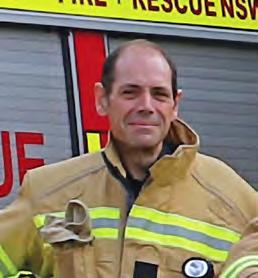
“His passion became community events that attracted hundreds of locals,” says Scott. “He ran a show alongside other passionate members who gave up their time to show off rare and collectible cars. He was also known for his car boot sales. You name it, he could organise it.”
In recent years, his weight loss and fitness journey became one of his biggest passions. He was a keen runner, often taking to social media to share his accomplishments in marathons and the City to Surf. He was known for his park runs and enjoyed being fit.
A decorated firefighter, Michael had a long history of accolades in both services. He was awarded a National Emergency Medal and a Premier’s Bushfire Citation for protecting his local community during the 2019/20 fire season and received a National Medal and a Long Service Medal from the RFS in 2013.
Michael will be remembered for his dedication to the community and his unwavering support to the state’s fire services.
BUSH FIRE bulletin | VALE 47
VALE
John Barry Holmes Senior Deputy Captain
1949 – 2023
On 14 October 2023, Senior Deputy Captain
John Holmes was helping battle the Bean Creek fire, approximately 15km north of Bonalbo in the Kyogle LGA, when he suffered a fatal medical episode.
John loved three things: his family, spending time on his farm and being an active firefighter.
After joining the Mallanganee Brigade in 1971, John quickly became an enduring and dedicated member. He was devoted to his community and enjoyed organising brigade events, maintenance days and training new members.
Mallanganee Brigade Captain Neville O’Malley praised his friend for his commitment to the Service.
“John was the type of exceptional member that every brigade needs, he was an experienced firefighter who was also ready and willing to assist in every aspect of day-today duties,” he said. “He mentored new members and was a genuinely great man to have by your side.”
During John’s career he was deployed to many out-of-area incidents to some of the state’s most significant bush fires.
Most notably, the 1993/94 fires that extended north from Sydney to the Queensland border impacting the North Coast and the Hunter, burning more than 800,000 hectares, as well as the 2002/03 southern NSW fires that burnt more than 1.46 million hectares in 151 consecutive days.
In the last few years, John’s unwavering commitment was still apparent as he worked tirelessly during the 2019/20 Black Summer fires and the 2022 Northern Rivers flood clean-up.
John received many accolades during his time as a member, having been awarded the National Emergency Medal, the National Medal, the RFS Long Service Medal with clasps, the NSW Premier’s Unit Citation and the Commissioner’s Commendation for Service.

Proudly, in June 2022, he received his Mallanganee Brigade Life Membership, marking an inspirational volunteer career of more than five decades.
Commissioner Rob Rogers and numerous RFS members came together with John’s family and friends on 3 November 2023 to celebrate his life and his dedication to the Service.
John’s legacy will forever be proudly etched in the history of the RFS and the Mallanganee Brigade. His passing was deeply felt, but his memory will continue to inspire fellow members into the future.

48 BUSH FIRE bulletin | VALE

VALE Leonardus (Leo)
Jacobus Fransen
Captain
1947 – 2023
On 16 November 2023, while attending the Hudson Fire in the Walgett LGA as part of an out-of-area strike team, Captain Leonardus (Leo) Jacobus Fransen was struck by a falling limb of a tree. Despite the immediate efforts of his fellow crew members and ambulance officers, he could not be saved.
Leo was a dedicated life member of the Diamond Beach Brigade on the Mid Coast. Joining in 2010, he held various roles and most recently served as Captain.
Committed to community service, Leo became involved with many aspects of life in the small township of Hallidays Point. He was a well-loved local, known affectionately as the ‘Mayor of Halliday Shores’, welcoming new arrivals at his retirement village.
He wore many ‘hats’, volunteering as bus driver and barman at social evenings.
Leo was a member of several clubs and a participant of events such as the ‘Relay for Life’, which raised funds for Cancer awareness.
A role model to many, he was awarded the Lions Citizen of the Year Award, Local Hero Award and was a local Ambassador at Australia Day celebrations.
Mid Coast Group Captain Eddy Merzlikoff was a colleague and friend of Leo’s for 13 years.
“Leo was incredibly unassuming, never promoting himself, he just did what needed to be done,” says Eddy. “He was the type of mate who had your back, ‘I’ve gotcha’ was his philosophy in life.
“A tall, strong man with a firm handshake, Leo was always inviting and wanting to engage,” says Eddy.
“He had a terrific smile that broke down barriers, but most of all, he loved to serve. In fact, if he wasn’t on the fireground you would say ‘where’s Leo?’ He was the first one to put his hand up.”
In his spare time, Leo loved nothing more than spending time with his wife and planning where to next visit in their caravan. He enjoyed cycling and watching rugby and soccer. He was a loyal Crystal Palace fan, often waking at 2am to watch the games live from England.
Eddy remembers his friend as the type of person who put safety first.
“Sadly, the irony was that Leo was ‘Mr safety’, emphasising that to his Brigade constantly. But when an accident happens within half a second, you can’t predict that.
“He was a great bloke, so humble, maybe that’s what endeared a lot of people to him. We had great times socially and on the fireground.”
Leo will be remembered by his Brigade as a brave leader with a big heart.
BUSH FIRE bulletin | VALE 49

LAKE ALBERT BRIGADE CELEBRATES ITS LONGEST SERVING MEMBER
In September, Lake Albert Brigade’s longest-serving member, James ‘Jim’ Simpson, received the Long Service Medal 6th Clasp for 70 years with the RFS.
Like his father and grandfather before him, Jim Simpson has left an indelible mark on the Lake Albert Brigade.
“September marked 70 years since I attended my first Brigade meeting,” says Jim. “It’s still a very active Brigade and though I’m not holding a hose anymore, my heart’s certainly in it.”
Since joining in 1953, Jim has held the positions of Secretary, Treasurer, Deputy Captain, Senior Deputy Captain, Captain and is in his 27th year as Brigade President.
Jim was instrumental in the acquisition and build-up of eight firefighting appliances and played a major role in acquiring the land for the current station. As a Group Captain and Training Officer, Jim has shared his extensive knowledge and leadership skills with the wider Riverina District.
As for what’s kept him in the Service for more than twothirds of a century, Jim says it’s the sense of comradery and mateship.
“As a Group Captain, I travelled to conferences all over the state and I’ve made good friends far and wide,” he says. “The people you meet and deal with are fantastic. Everyone’s got the same purpose and I’ve had a wonderful time.
“I think what makes a good firefighter is the enthusiasm to work with teammates. It’s the same as a football team – if you don’t work as a team, you won’t achieve what you have set out to do.”
Jim says things have come a long way since he joined the RFS, from watching his father fight fires with the
Brigade’s only petrol-powered pump, to watching waterbombing aircraft conduct training on his property. The goal, however, has remained unchanged.
“The excitement of being a firefighter is one thing, but the first RFS Brigade formed down in Berrigan by the local township was formed to help protect each other, it’s about helping your neighbour,” he says. “It’s been a very rewarding life.”
Congratulations Jim for reaching this extraordinary milestone and thank you for so many years of dedicated service.

50 BUSH FIRE bulletin | GENERAL NEWS
Main: Lake Albert Brigade’s longest serving member, James Simpson, receiving his Long Service Medal for 70 years with the RFS. Article originally appeared in The Daily Advisor.

ALPINE/AYLMERTON BRIGADE CELEBRATES 70TH ANNIVERSARY AND HONOURS MEMBERS
RFS members gathered in Alpine in the Southern Highlands on 5 November 2023 to celebrate the 70th anniversary of the Alpine/Aylmerton Brigade and present members with medals in recognition of their dedication and service.
Formed in 1953, the Brigade now boasts 49 members and is very active within the community, running several training courses for other RFS members across the Southern Highlands District.
Assistant Commissioner Stuart Midgley joined special guests in congratulating members past and present for building the Brigade into the community focal point it is today.

“The celebration was an opportunity to not only congratulate the Brigade on this milestone but also thank members for their ongoing commitment and service, with the presentation of seven National Medals, three Long Service Medals and three Life Memberships.
“The event provided an opportunity to recognise members of the Brigade who together have amassed more than 300 years of service to the RFS.”
ALAN KERSLAKE
Veteran life-long member Alan Kerslake was recognised for his dedication to the RFS. Alan was just a teenager when his father started the Brigade in 1953.
Now in his eighties, and after 69 years with the Service (including 12 years as Captain), he’s still carrying on the legacy with his brother.
In those early days, Alan attended fires on his bike, armed with a backpack and a pager. He was known as the ‘runner’, cycling around the neighbourhood to advise locals of the threat of fire.
Back when the Brigade was first formed, his father’s family truck was used to protect the village. Their first tanker, an ex-army blitz, was housed on the Kerslake property with Alan maintaining it for many years.
Today, the Alpine/Aylmerton Brigade has two firefighting appliances both equipped with breathing apparatus.
Alan also received a Commissioner’s Commendation for Service in 2023.
PROFILE
Main: Officials and Brigade members at the Alpine/Aylmerton Brigade’s 70th anniversary celebration. Above: Alan proudly receiving his 60 years medal clasp and 65 years National Medal clasp. BRIGADE
IN
BUSH FIRE bulletin | BRIGADE IN PROFILE 51
OUR BUSH FIRE BULLETIN

HISTORY
Press advertisement for the Bush Fires Act booklet, circa 1975 52 BUSH FIRE bulletin | OUR BULLETIN HISTORY
BUSH FIRE BULLETIN on
The RFS has joined forces with the National Library of Australia to digitise the entire collection of the Bush Fire Bulletin dating back to September 1952.

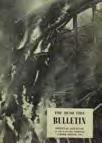



All editions of the Bush Fire Bulletin are available online. The collection brings to life the important work our members have undertaken over the years.
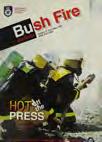



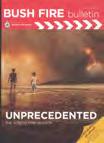
How to search for Bush Fire Bulletin on Trove
On the Library page of the RFS website, you will find links to browse the various collections of the Bush Fire Bulletin. You can search place names, brigade names, dates and fire-related topics such as ‘fire trails’ or ‘large air tanker’.
CREATE YOUR SUBSCRIPTION

Mail to:
Bush Fire Bulletin
NSW RURAL FIRE SERVICE
Reply Paid 67059
Locked Bag 17
Granville NSW 2142
(No stamp required)
Name:
Subscribe to the print edition or update your details by emailing bush.fire.bulletin@rfs.nsw.gov.au . Alternatively you can fill out the form below and send it in.
I am an RFS member
Address:
PLEASE SUBSCRIBE ME TO THE PRINT VERSION
I am a new subscriber
Email address:
Postcode:
Update my current details eBulletin (email required)
If you would prefer to view the magazine online, please tick ‘Online Only Subscription’ and provide your email address. Alternatively, scan the QR code at right and follow the prompts.
ONLINE ONLY SUBSCRIPTION
Name:
(Please include any post-nominals)
Email address:
THE JOURNAL OF THE NSW RURAL FIRE SERVICE 06 14 IN THIS ISSUE TSUNAMI VICTIMS SAFELY LOWER HUNTER
BUSH FIRE BULLETIN
ISSN: 1033-7598
Publisher: NSW Rural Fire Service I Produced by RFS Media and Communications. Editor: Lyndal Sayer. Layout and design: Nick Lockwood. Printed on Monza Gloss; FSC (CoC), ISO 14001, IPPC, ECF environmental accreditation.
Postal address
NSW Rural Fire Service Locked Bag 17 GRANVILLE NSW 2142
Social Media
www.facebook.com/nswrfs/ @NSWRFS @NSWRFS
T (02) 8741 5555 F (02) 8741 5550 W rfs.nsw.gov.au E Bush.Fire.Bulletin@rfs.nsw.gov.au


PP100003459
Street address NSW Rural Fire Service 4 Murray Rose Ave Sydney Olympic Park NSW 2127
Cover photo: Image taken in Toorooka, NSW, October 2023 by Amanda Williams.







 Rob Rogers AFSM Commissioner
Rob Rogers AFSM Commissioner












 Main photo: Photo by Ivan Perkins, performing an air attack role. Above: Photo by Mark Bathgate. Below: Aerial image supplied by RFS.
Main photo: Photo by Ivan Perkins, performing an air attack role. Above: Photo by Mark Bathgate. Below: Aerial image supplied by RFS.


















 Main image: Toorooka, NSW, burnt during recent fires.
Bottom left: RFS firefighters at Hat Head, NSW. Photos by Amanda Williams. Below: Willi Willi fire, 2023. Photo supplied by RFS.
Main image: Toorooka, NSW, burnt during recent fires.
Bottom left: RFS firefighters at Hat Head, NSW. Photos by Amanda Williams. Below: Willi Willi fire, 2023. Photo supplied by RFS.












 Main image: Photo by Melissa Hams, c/o NSW DPE. Above: A ceremony centered around an image of the malleefowl totem. Photo by Danny Busch. Below: A malleefowl. Photo by Melissa Hams, c/o NSW DPE..
Main image: Photo by Melissa Hams, c/o NSW DPE. Above: A ceremony centered around an image of the malleefowl totem. Photo by Danny Busch. Below: A malleefowl. Photo by Melissa Hams, c/o NSW DPE..







 Top left: Members of the public attend the Bellingen Brigade engagement. Top and bottom right: Captain Kev Doye operating the Simtable. Bottom left: Senior Deputy Captain Simon Borgert following up with detailed bush fire planning in the training room.
Photos courtesy of North Bellingen Brigade.
Top left: Members of the public attend the Bellingen Brigade engagement. Top and bottom right: Captain Kev Doye operating the Simtable. Bottom left: Senior Deputy Captain Simon Borgert following up with detailed bush fire planning in the training room.
Photos courtesy of North Bellingen Brigade.















 Terrey Hills
Terrey Hills



 Brigade photos by RFS members on Get Ready Weekend. Warrimoo photo by Jacqueline Murphy.
Ingleside
Hazelbrook
Batemans Bay
Brigade photos by RFS members on Get Ready Weekend. Warrimoo photo by Jacqueline Murphy.
Ingleside
Hazelbrook
Batemans Bay

































